在當今移動互聯網時代
Hey, a new email service from the makers of Basecamp was recently launched. The Verge calls it a “genuinely original take on messaging”, and it indeed features some refreshing ideas for the sometimes painful exercise we call inbox management.
嗨 ,Basecamp的制造商最近推出了一項新的電子郵件服務。 Verge 稱其為“原始的消息傳遞方式” ,確實為一些有時令人痛苦的練習(我們稱為收件箱管理)提供了一些新穎的想法。
For this occasion, I wanted to take a closer look at how this new email service and two other popular providers — namely, Gmail and Outlook — compare. The article highlights the best approaching for the following topics:
為此,我想仔細研究一下這個新的電子郵件服務與其他兩個受歡迎的提供商Gmail和Outlook的比較。 本文重點介紹了以下主題的最佳方法:
Email categories and unreads
電子郵件類別和未讀
Marking and snoozing
標記和貪睡
Project management
項目管理
Attachments
附件
Unwanted emails and spam filtering
不需要的電子郵件和垃圾郵件過濾
Notifications and privacy
通知和隱私
Extra features
額外功能
As this is a lengthy piece, if you’re just interested in a specific category, you can navigate to specific sections with the links above. If you’re only in for the TL;DR, then jump straight to the conclusion at the end.
由于篇幅冗長,因此,如果您只對特定類別感興趣,則可以使用上面的鏈接導航到特定部分。 如果僅是TL; DR,請直接跳到最后的結論 。
Let’s look at how Gmail, Outlook, and Hey approach getting things done!
讓我們看看Gmail,Outlook和Hey如何完成工作!
🔸電子郵件類別和未讀 (🔸 Email categories and unreads)
All three providers take different directions when automatically categorizing your messages. For managing unread emails, there is not much of a contrast.
自動分類您的消息時,所有三個提供者都采用不同的方向。 對于管理未讀電子郵件,沒有太大的反差。
郵箱 (Gmail)
Google’s email service offers the most categorization options. By default, it puts your messages automatically into five categories: Primary, Social, Promotions, Updates, and Forums. This approach hides not-so-important messages from the default view.
Google的電子郵件服務提供最多的分類選項。 默認情況下,它會將您的郵件自動分為五個類別:主要,社交,促銷,更新和論壇。 這種方法在默認視圖中隱藏了不太重要的消息。

Beyond that, Gmail offers several lesser-known inbox types too.
除此之外,Gmail還提供了幾種鮮為人知的收件箱類型。
You can set your inbox Important first, which, as the name indicates, is prioritizing messages judged to be important. You can also have an Unread first or Starred first setting, which displays your unread or starred emails on the top of the batch. There is even a Priority inbox option that combines some of the earlier approaches. It shows several sections on top of each other, ranking based on their likely importance to you.
您可以將收件箱中的“ 重要”設置為“ 第一” ,顧名思義,該郵件將優先處理被認為重要的郵件。 您還可以設置“ 未讀優先”或“已加星標”設置,該設置在批次頂部顯示未讀或已加星標的電子郵件。 甚至還有一個“ 優先收件箱”選項,它結合了一些較早的方法。 它顯示了幾個相互重疊的部分,并根據它們對您的重要性進行排名。
In Google’s service, unread emails are usually appearing among the rest of the messages, which are in a reverse chronological order. There are exceptions to that, if you use options like Unread first, that will group unreads together, no matter when they arrived to your inbox.
在Google的服務中,未讀電子郵件通常會出現在其余郵件中,并按時間倒序排列。 除此之外,如果您使用Unread first之類的選項,則無論未讀內容何時到達收件箱,它們都會將未讀內容組合在一起。
外表 (Outlook)
Microsoft’s approach for automatically organizing emails is relatively simple. When you start using the service, there is a Focused inbox feature enabled that sorts incoming messages into a Focused and an Other tab. Outlook is also trying to hide less relevant emails into a separate section. If you don’t like it, you can turn the feature off anytime. Disabling it would result in a classic email view with threads, starting with the newest message.
微軟自動組織電子郵件的方法相對簡單。 當您開始使用該服務時,將啟用“ 焦點收件箱”功能,該功能可將傳入郵件分類為“ 焦點”和“ 其他”選項卡。 Outlook還試圖將不相關的電子郵件隱藏到單獨的部分中。 如果您不喜歡它,則可以隨時關閉該功能。 禁用它會導致帶有最新消息開始的帶有線程的經典電子郵件視圖。
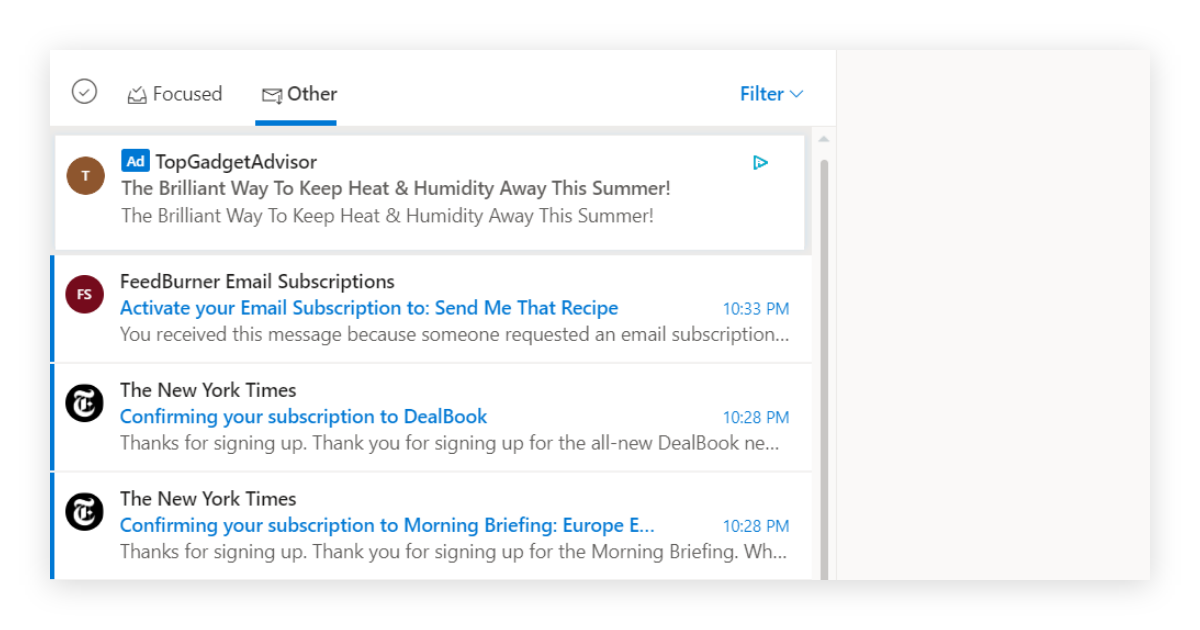
Alternatively, using a filter, it’s possible to narrow down to specific emails, such as unreads, flagged ones, and emails with mentions or attachments. These filters don’t stick, so if you go to another folder and then come back to your inbox, you’re facing with the default view again. In the filter menu, there is also an option offering message sorting based on importance.
另外,使用過濾器,可以縮小到特定電子郵件的范圍,例如未讀,已標記的電子郵件以及帶有提及或附件的電子郵件。 這些過濾器不會粘住,因此,如果您轉到另一個文件夾然后返回到收件箱,則將再次面臨默認視圖。 在過濾器菜單中,還有一個選項可根據重要性對郵件進行排序。
Unread emails are appearing in between other read messages, similar to Gmail, except when the view is filtered to show unread messages only.
未讀電子郵件出現在其他已讀郵件之間,類似于Gmail,但將視圖過濾為僅顯示未讀郵件時除外。
嘿 (Hey)
The new email service, Hey, is changing some of the decade-old patterns that would surely need some getting used to.
全新的電子郵件服務Hey,正在改變一些已有十年歷史的模式,這些模式肯定需要習慣。
First, new messages from first-time senders are not going to the main inbox automatically but put to The screener section. Imagine it as a night club bouncer who is keeping the line outside.
首先,來自首次發件人的新郵件不會自動轉到主收件箱,而是會放入“篩選器”部分。 想象一下,作為夜總會的保鏢,他正在外面排隊。
If you say yes to someone’s email, their future messages will keep landing in your inbox. If you say no, their communications won’t appear visibly in your mailbox but their incoming messages will be retained for 90 days. While it’s a visual way to manage who can get your attention, it’s also a manual process.
如果您對某人的電子郵件說“是”,那么他們將來的郵件將繼續進入您的收件箱。 如果您拒絕,則他們的通訊將不會在您的郵箱中顯示,但他們的傳入消息將保留90天。 盡管這是一種可視化的方法來管理誰可以引起您的注意,但這也是一個手動過程。

For marketing and promotional emails, Hey offers a separate section called The feed. It’s like an infinite-scrolling Facebook feed, with the latest messages on top, without any indication if something is new or not. Unfortunately, at the time of the writing, there is nothing similar to Instagram’s “You’re all caught up” notice when you reach a previously read message.
對于營銷和促銷電子郵件,Hey提供了一個單獨的部分,稱為The feed 。 就像無限滾動的Facebook提要,頂部是最新消息,沒有任何新消息。 不幸的是,在撰寫本文時,當您收到以前閱讀的消息時,沒有什么與Instagram“所有人都被抓到”通知相似。
You can also mark senders to be automatically sent to The feed, in which case they would skip your primary inbox.
您還可以將發件人標記為自動發送到The feed ,在這種情況下,他們將跳過您的主要收件箱。
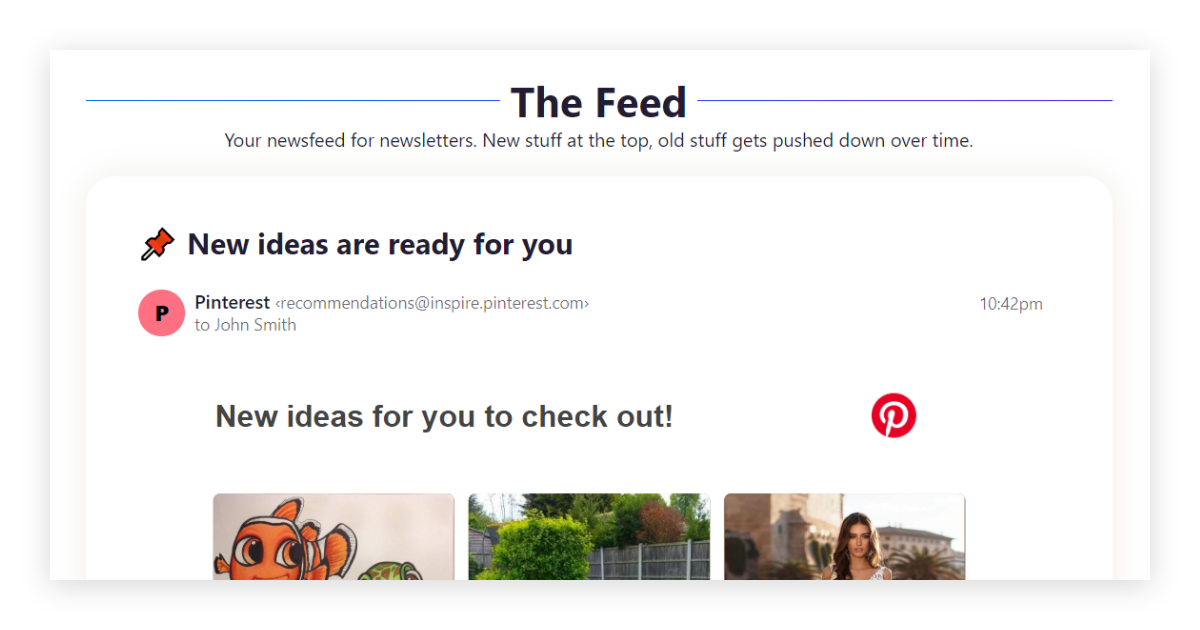
The last dedicated category Hey has is The paper trail. It’s similar to Gmail’s Updates section, where receipts and confirmations usually appear. This category also has manual controls; messages only appear here if you decide so. Emails are organized similarly to your primary inbox, the newest ones being on the top.
嘿的最后一個專門類別是論文線索 。 與Gmail的“ 更新”部分類似,該部分通常會顯示收據和確認。 此類別還具有手動控件。 如果您決定,則僅在此處顯示消息。 電子郵件的組織方式與您的主要收件箱相似,最新的郵件位于頂部。
One bottleneck of this approach if there are multiple types of emails coming from one email address. Hey, at the moment, cannot distinguish these, and all emails from one sender can only land in one of the categories.
如果從一個電子郵件地址發送多種類型的電子郵件,則此方法的瓶頸。 嘿,目前無法區分這些,來自一個發件人的所有電子郵件只能歸入以下類別之一。
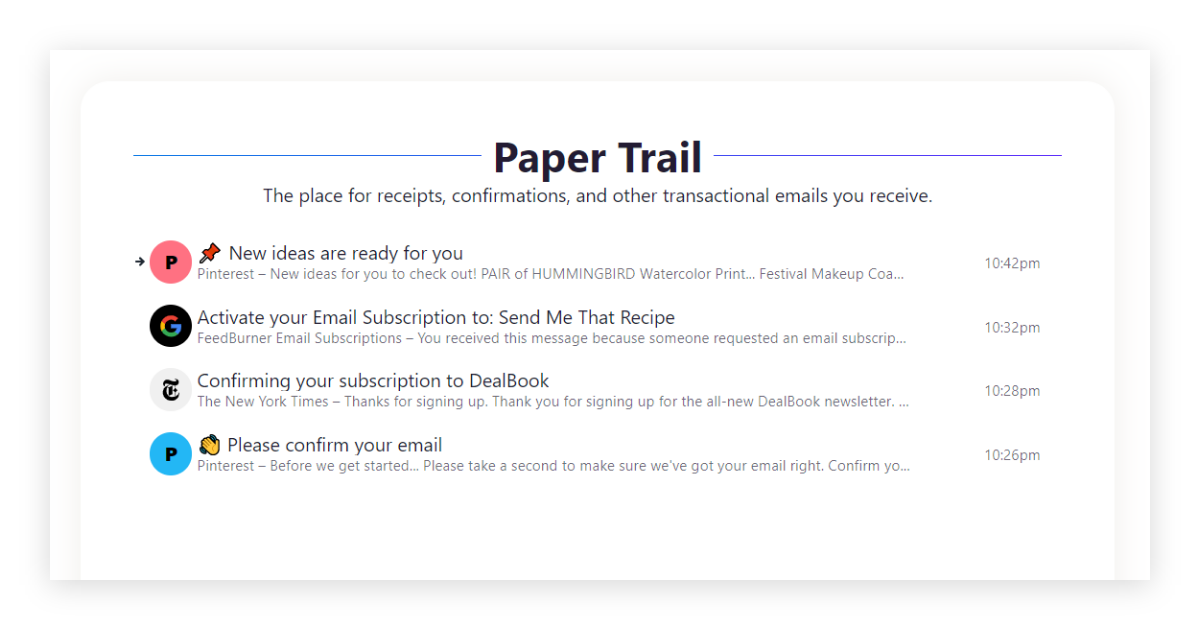
for電子郵件類別和未讀管理的最佳方法:Gmail。 (🎉 The best approach for email categories and unread management: Gmail.)
All three email providers are trying to separate relevant content from the noise. While Hey is doing that based on your previous decisions, Gmail wins with their algorithmical approach that works from day one.
所有這三個電子郵件提供商都試圖將相關內容與噪音分開。 在Hey根據您之前的決定進行此操作的同時,Gmail憑借從一開始就可以使用的算法方法獲勝。
🔸標記和貪睡 (🔸 Marking and snoozing)
Tagging is a universal pattern that none of the services could have avoided. On the other hand, they take different ways on how to deal with email postponing.
標記是一種通用模式,所有服務都無法避免。 另一方面,他們在處理電子郵件延遲方面采取了不同的方法。
郵箱 (Gmail)
In Gmail, there are two alternatives to marking emails.
在Gmail中,有兩種標記電子郵件的方法。
One is to star messages you want to remember. By doing, they’ll become available in a dedicated Starred section, even if you archive a thread.
一種是給要記住的郵件加注星標。 這樣一來,即使您歸檔了一個線程,它們也將在專用的加星標部分中變得可用。
The other alternative is to apply labels. By tagging emails, you can make up your own categories, like separate labels for hobbies and work.
另一種選擇是應用標簽。 通過標記電子郵件,您可以組成自己的類別,例如,愛好和工作的單獨標簽。
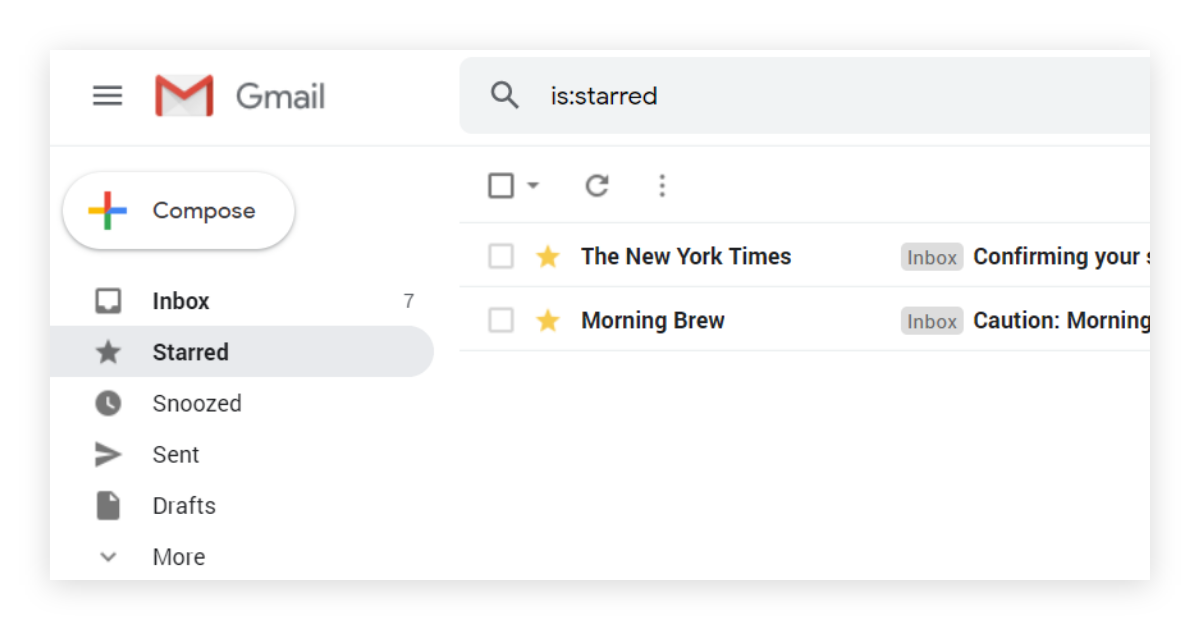
In addition to marking, Gmail makes it possible to snooze messages. This functionality is useful if you want to deal with an email later when it is actually relevant to you. When you use this feature, emails disappear from the primary inbox and only reappear at the date and time you specify.
除了標記外,Gmail還可以使郵件暫停。 如果您想稍后處理與您實際相關的電子郵件,此功能很有用。 使用此功能時,電子郵件將從主收件箱中消失,僅在您指定的日期和時間重新出現。
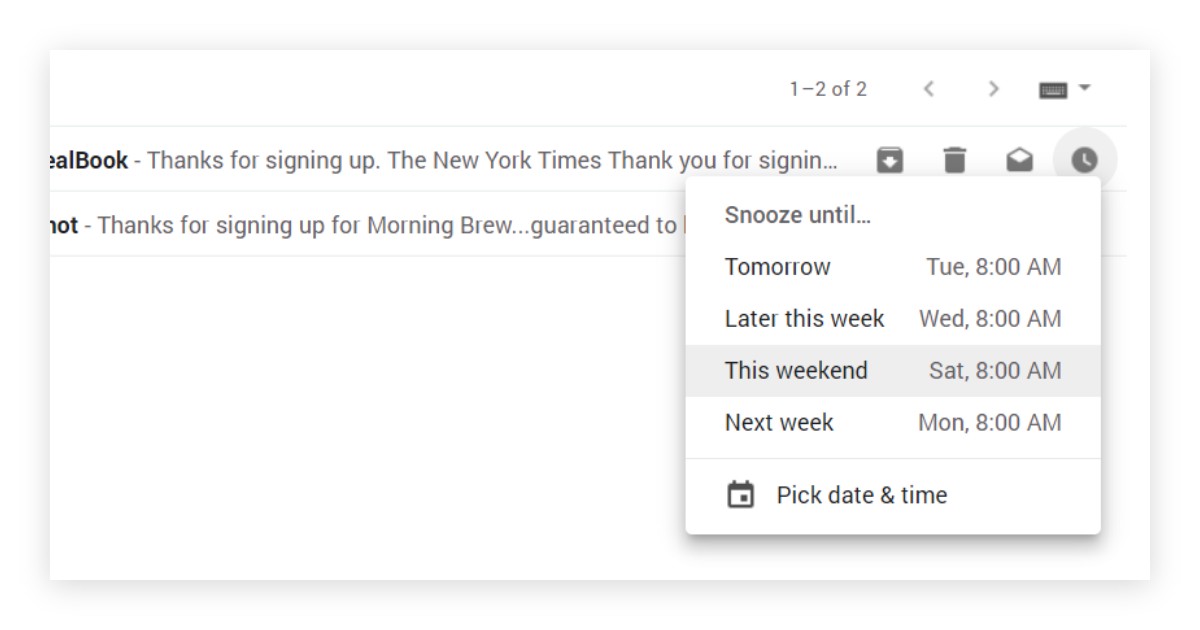
外表 (Outlook)
Outlook offers three ways to highlight messages.
Outlook提供了三種突出顯示郵件的方法。
First, you can flag emails, similar to starring in Gmail. The only difference that flagging has three states: unflagged, flagged, and completed. That makes the functionality a tiny bit more beneficial if you’re looking for a way to distinguish items that you haven’t flagged and the ones that you’ve completed.
首先,您可以標記電子郵件,類似于在Gmail中加注星標。 標記的唯一區別是具有三種狀態:未標記,標記和完成。 如果您正在尋找一種方法來區分未標記的項目和已完成的項目,那么這會使該功能更加有用。
Second, you can use labels, called as categories. Categories can have a pre-defined color, and they are shared between your email and calendar items. That fact comes with the limitation that you cannot use different labels for events and messages.
其次,您可以使用稱為類別的標簽。 類別可以具有預定義的顏色,并且可以在您的電子郵件和日歷項目之間共享。 事實是,您不能為事件和消息使用不同的標簽。
Third, you can pin items to the top of your inbox. This feature is also handy, as it removes the need to switch in between views to find something that you wanted to keep in your focus. Unfortunately, pinning is only available on the desktop interface and not yet present in the mobile app.
第三,您可以將項目固定在收件箱頂部。 此功能也很方便,因為它消除了在視圖之間切換以查找要保持焦點的需求。 不幸的是,固定僅在桌面界面上可用,而在移動應用程序中尚不存在。
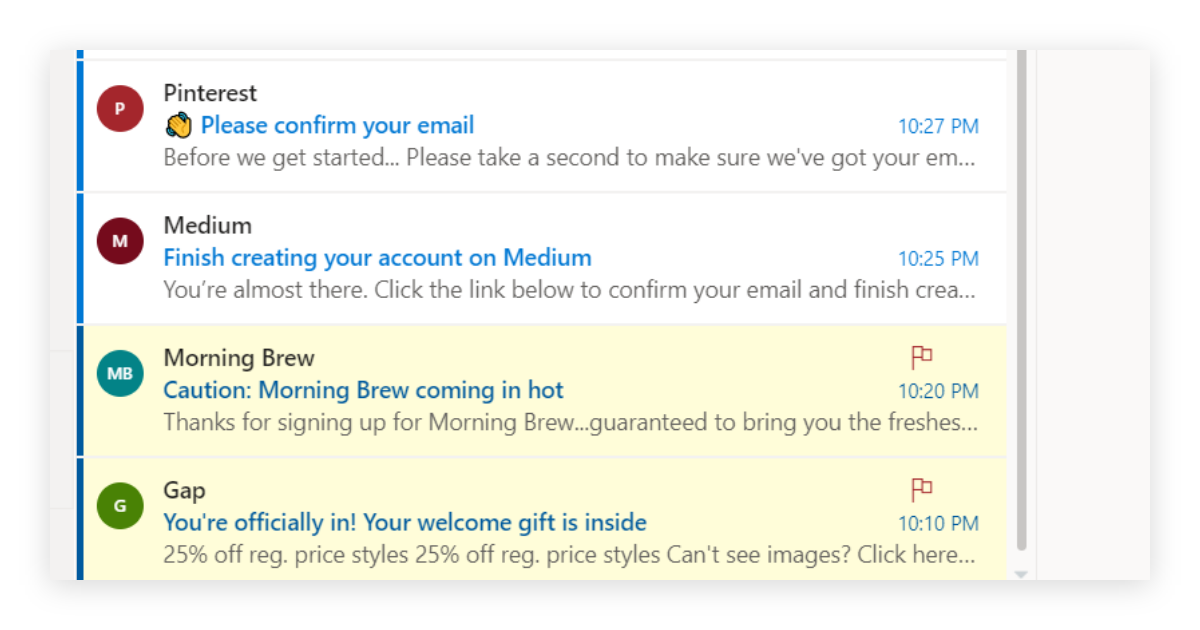
Outlook has also adopted email snoozing. Available after a long tap in the mobile app, Microsoft offers more pre-defined options than Gmail. Sadly, those suggestions are not editable, so if you don’t want to pick the time manually, you’re stuck with Microsoft’s definition of morning and evening.
Outlook還采用了電子郵件暫停功能。 在移動應用程序中輕按一下即可使用,Microsoft提供了比Gmail更多的預定義選項。 可悲的是,這些建議是不可編輯的,因此,如果您不想手動選擇時間,那么您將對Microsoft早晚的定義感到困惑。
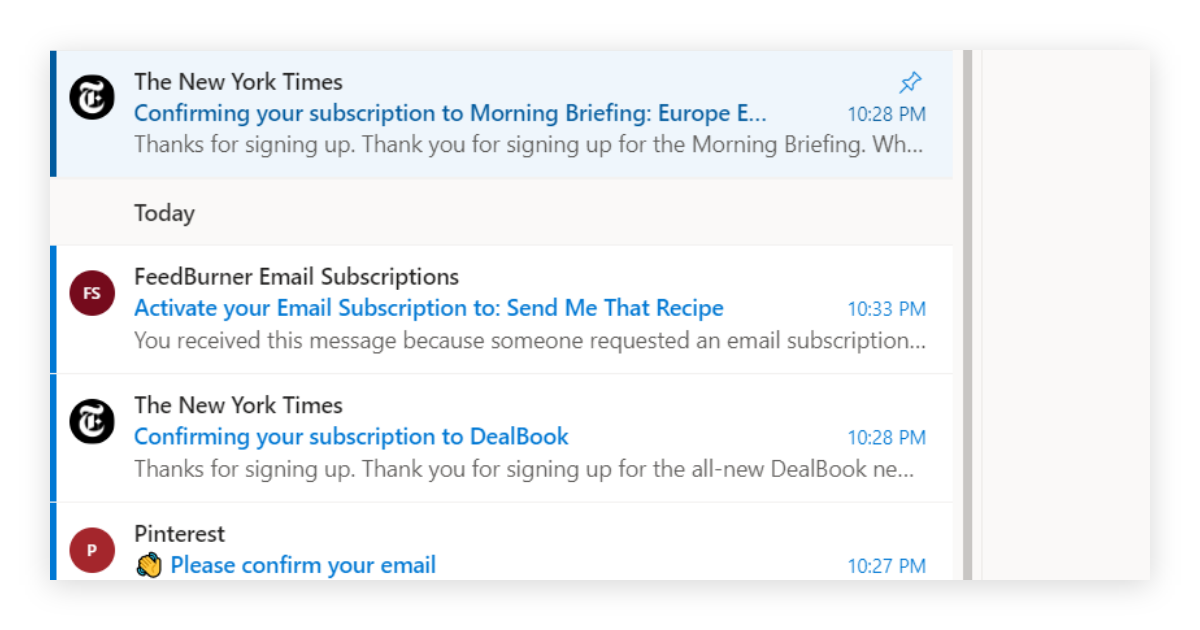
嘿 (Hey)
Hey also offers the option to utilize labels for tagging threads. Beyond that, the provider approaches categorizing emails a bit differently.
嘿還提供了利用標簽標記線程的選項。 除此之外,提供商對電子郵件的分類方式有所不同。
Instead of starring or flagging, Hey’s dedicated section is called Set aside. If you set a message aside, it disappears from your inbox and goes to another folder. From the main screen, you can access both the separate folder and the first few emails in there. In Set aside, saved emails are displayed in a grid, letting you peek at the first few lines of the message. It’s the right approach for a couple of emails, but it becomes hard to manage with over 30 messages.
而不是加注星標或標記,Hey的專用部分稱為Set aside 。 如果您將郵件放在一邊,該郵件將從收件箱中消失,并轉到另一個文件夾。 在主屏幕上,您可以訪問單獨的文件夾和其中的前幾封電子郵件。 在“ 預留”中 ,已保存的電子郵件將顯示在網格中,從而使您可以窺視郵件的前幾行。 對于幾封電子郵件,這是正確的方法,但要處理超過30條消息,將變得非常困難。
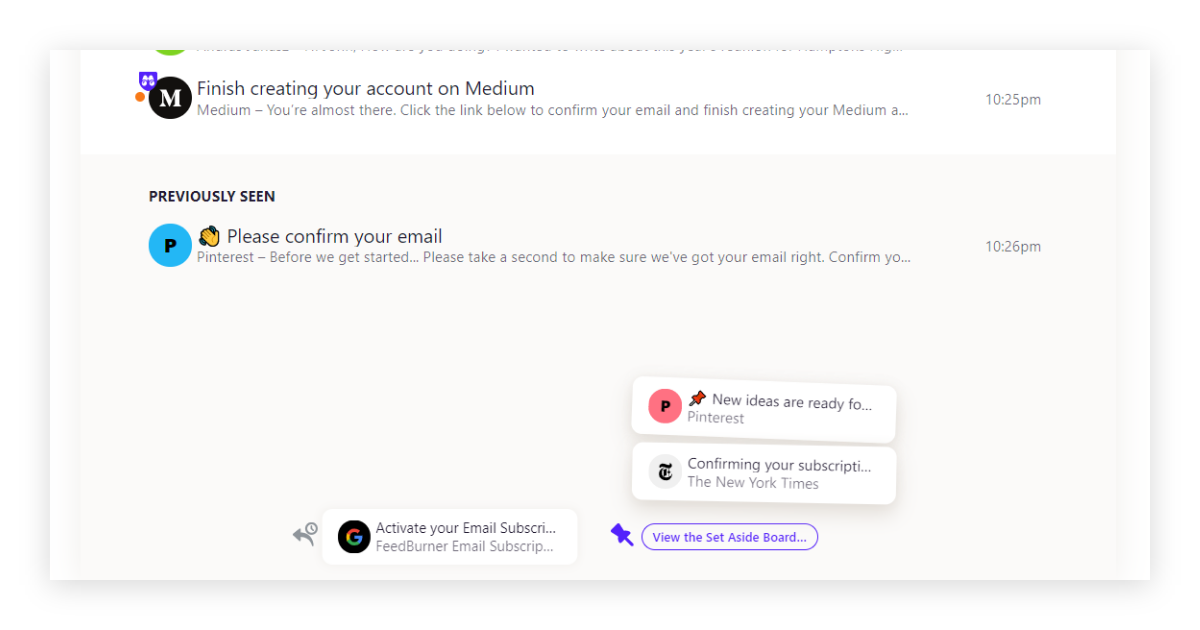
Another route where Hey is taking a different direction is snoozing. Instead of making emails to appear at a later time, users can mark them as Reply later. The section is available from the primary screen, with the first few emails visible on hover. Messages won’t just magically reappear at a later time; you have to go to this page purposefully if you want to take care of those emails.
Hey采取不同方向的另一條路線是打oo。 用戶可以將電子郵件標記為“ 稍后答復” ,而不是使電子郵件稍后顯示 。 該部分位于主屏幕上,懸停時顯示前幾封電子郵件。 郵件不僅會在以后神奇地重新出現; 如果您想處理這些電子郵件,則必須有目的地轉到此頁面。
To support that activity, Hey also has a Focus & reply feature. This functionality displays all your emails in Reply later after each other. Instead of jumping to separate threads, you can scroll down, write your response, press send, and scroll down again for the next message.
為了支持該活動,Hey還具有“ 焦點和回復”功能。 此功能稍后互相顯示“ 回復”中的所有電子郵件。 您可以向下滾動,編寫您的回復,按Send(發送),然后再次向下滾動以查看下一條消息,而不必跳到單獨的線程。
One thing that I miss from this feature is the ability to set specific dates. Having a power-user feature like Focus & reply is excellent but emails are usually not coming in in the desired order of dealing with those.
我從此功能中錯過的一件事是可以設置特定日期。 具有諸如“ 焦點與回復”之類的高級用戶功能非常出色,但是電子郵件通常無法按照所需的順序處理。
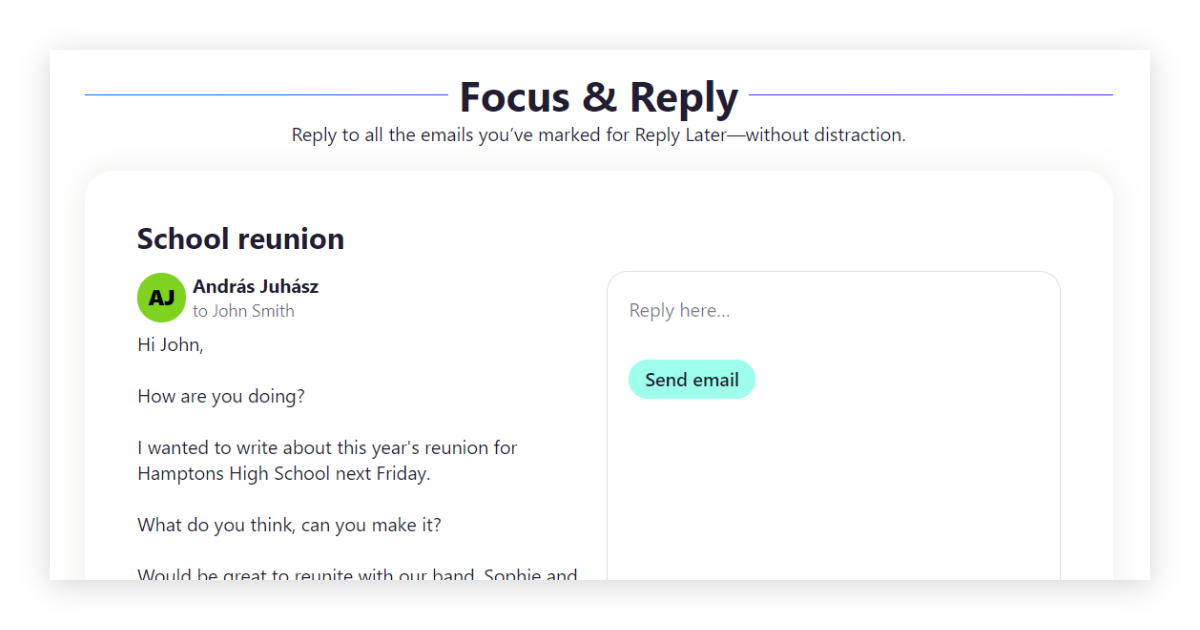
The last standout feature of Hey in marking emails is the ability to take notes and highlight sections. Interestingly, none of the other providers delivered this exact idea before but it makes perfect sense. The ability to take private notes for emails is useful, no matter if you’re jotting down thoughts or adding some extra information to keep in mind. However, don’t consider adding your passwords to registration confirmations.
Hey標記電子郵件的最后一個突出功能是能夠記錄筆記和突出顯示部分。 有趣的是,沒有其他提供者以前曾提供過這個確切的想法,但這是很有意義的。 不管您是記筆記還是添加一些其他信息以備記用,為電子郵件添加私人筆記的功能都非常有用。 但是,不要考慮將密碼添加到注冊確認中。
Fascinating though that Hey played with the note-taking concept so much that they had three ideas and instead of selecting the best, they went with all.
盡管Hey非常喜歡記筆記的概念,以至于他們有了三個想法,但他們并沒有選擇最好的想法,而是全力以赴。
For one, you‘re able to take notes in between conversations in a thread. These notes appear as blue stickers that are different in shape and size than regular messages, so they’re easy to spot.
首先,您可以在一個會話的對話之間做筆記。 這些筆記顯示為藍色貼紙,其形狀和大小與常規消息不同,因此很容易發現。
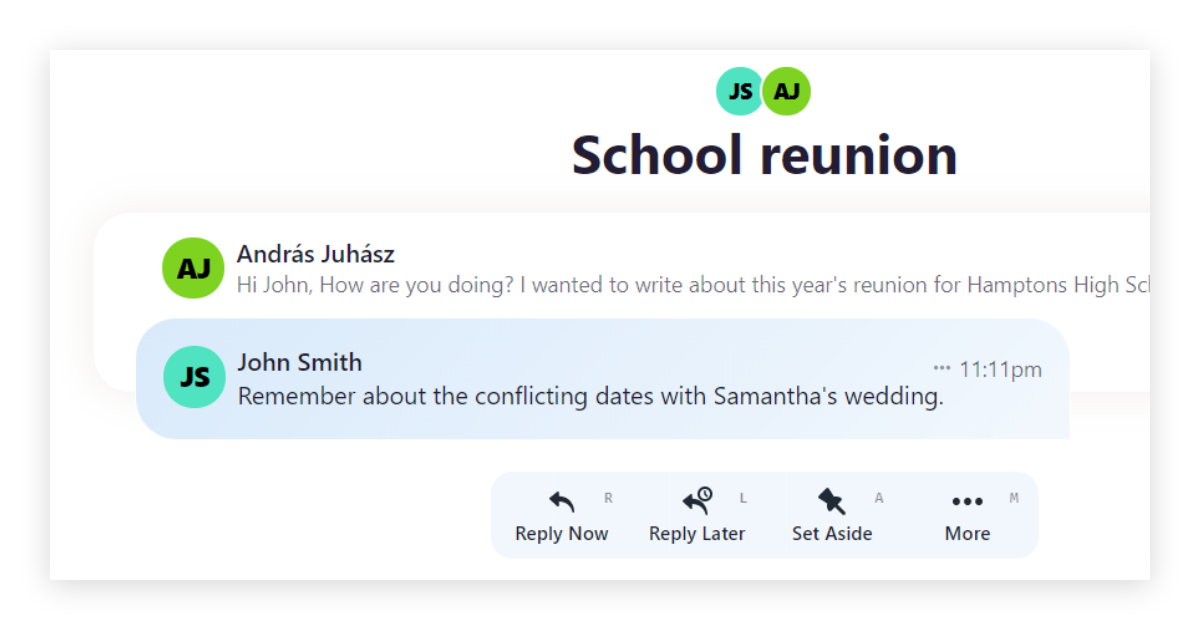
Second, you can add a yellow sticky note (only one) to any thread you desire. Those notes will be visible next to emails in list views, making them stand out from the crowd.
其次,您可以在所需的任何線程中添加黃色便箋(僅一個)。 這些注釋將在列表視圖中的電子郵件旁邊顯示,從而使其在人群中脫穎而出。
Third, you’re able to select specific parts from an email and save it as a Clip. These saves appear on a separate page after each other, including the sender and the subject. Clips come in handy to save relevant sections and might replace fiddling with other note-taking applications.
第三,您可以從電子郵件中選擇特定的部分并將其另存為Clip 。 這些保存內容彼此相繼出現在單獨的頁面上,包括發件人和主題。 剪輯非常有用,可以節省相關部分,并且可以用其他記筆記應用程序代替。
While taking notes is useful in Hey, you can lose track of in what format you saved something before. Search should not only work very well for finding emails but also for surfacing your private notes and clips.
記筆記在Hey中很有用,但您可能無法記住以前保存內容的格式。 搜索不僅可以很好地用于查找電子郵件,而且還可以顯示私人筆記和剪輯。
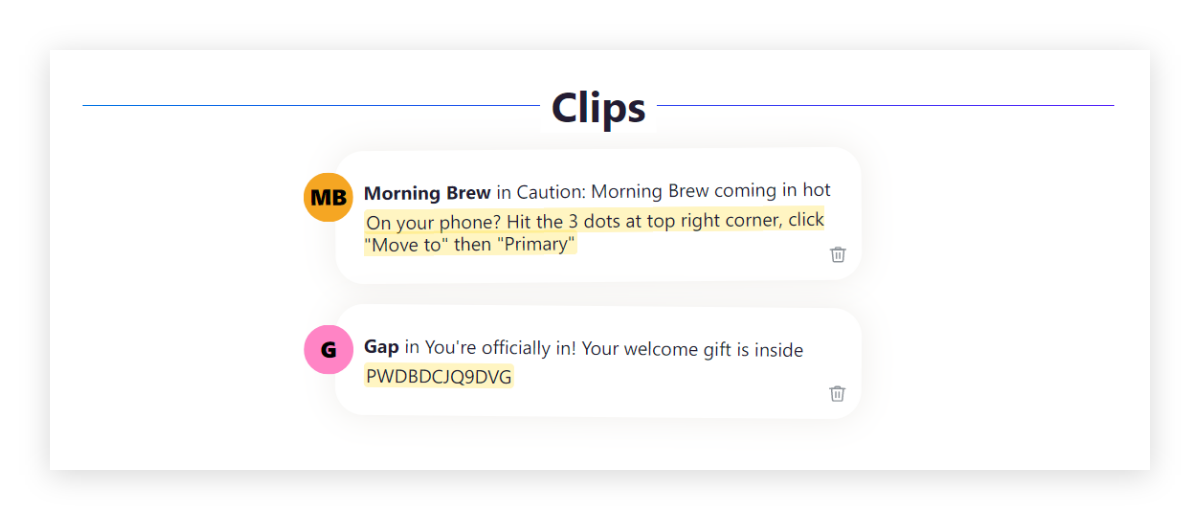
marking標記和貪睡的最佳方法:嘿。 (🎉 The best approach for marking and snoozing: Hey.)
While Gmail is taking the classic snoozing approach, Hey is trying to provide power-user features to finish inbox management tasks faster. However, Hey overcomes Gmail with their marking and note-taking features.
Gmail采用經典的貪睡方式時,Hey嘗試提供高級用戶功能,以更快地完成收件箱管理任務。 但是,Hey通過其標記和筆記功能克服了Gmail。
🔸項目管理 (🔸 Project management)
Project management capabilities are needed for work accounts when people just receive too many emails to handle it with a single inbox. How do these email providers compare?
當人們剛收到太多電子郵件無法通過一個收件箱處理工作帳戶時,工作帳戶就需要項目管理功能。 這些電子郵件提供商如何比較?
郵箱 (Gmail)
Google’s service utilizes previously discussed baked-in categories (like Social or Promotions) and user-created labels to sort messages.
Google的服務利用先前討論的內置類別(例如“社交”或“促銷”)和用戶創建的標簽對郵件進行排序。
Categories can be useful to isolate noise from relevant emails, but alone it doesn’t replace the manual grooming of your inbox. These categories can be hidden from the list view but they cannot be fully disabled.
類別對于將噪音與相關電子郵件隔離開很有用,但是單獨使用類別并不能代替收件箱的手動整理。 這些類別可以從列表視圖中隱藏,但不能完全禁用。
User-created labels take place on the left side of the screen. They’re visible based on the user’s setting, which may mean three scenarios:
用戶創建的標簽出現在屏幕的左側。 根據用戶的設置,它們是可見的,這可能意味著三種情況:
- always there, 一直在那,
- only there if there is an unread message under the label, 僅在標簽下有未讀郵件的情況下,
- or never appearing. 或永遠不會出現。
Besides, tags can be nested under parent items, making it possible to build a tree-structure for serious project management needs. Also, each label color can be customized.
此外,可以將標簽嵌套在父項下,從而可以為嚴重的項目管理需求構建樹形結構。 同樣,每種標簽顏色都可以自定義。
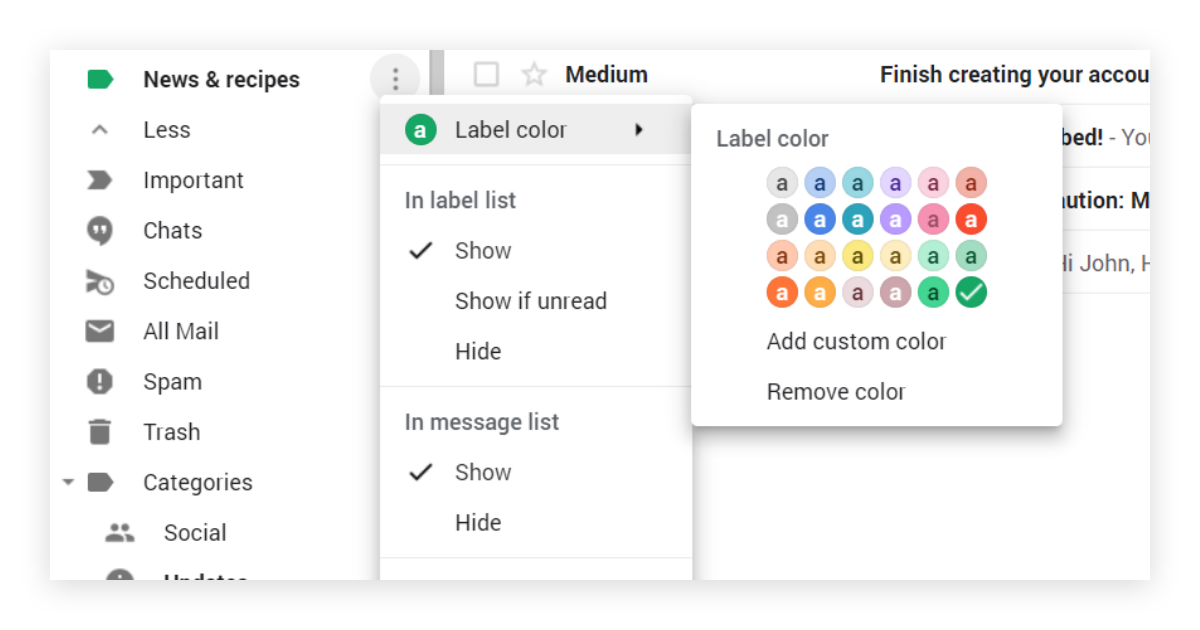
Beyond that, Gmail has an integration with Google Tasks. This feature enables emails to be added as tasks on the web, with the option to add subtasks, a description, and a due date. Google‘s task management solution appears on the right side of Gmail, as an official add-on like Google Keep or Google Calendar. While task management is technically not part of the core Gmail solution, the close integration can extend Google’s email offering.
除此之外,Gmail還與Google Tasks集成在一起。 此功能使電子郵件可以作為任務添加到Web上,并可以選擇添加子任務,描述和截止日期。 Google的任務管理解決方案顯示在Gmail的右側,是Google Keep或Google Calendar這樣的官方附加組件。 從技術上講,任務管理不是核心Gmail解決方案的一部分,但緊密的集成可以擴展Google的電子郵件服務。
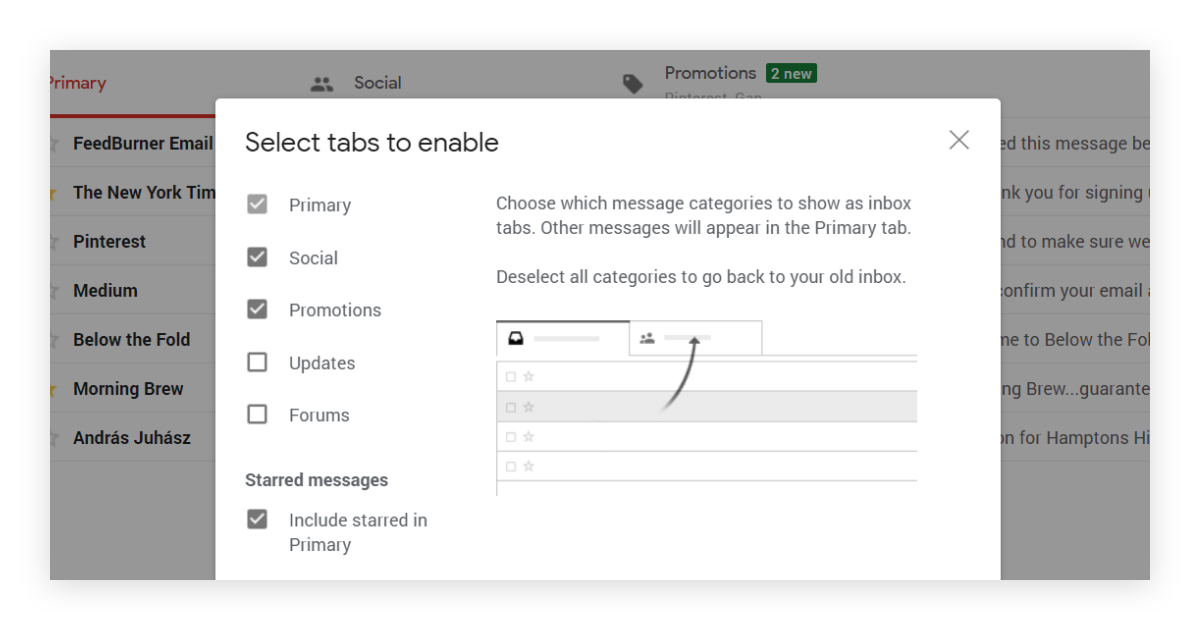
外表 (Outlook)
In Outlook, labels are called categories.
在Outlook中,標簽稱為類別。
Emails and calendar events are sharing the same set of categories which can be customized with pre-defined colors and also marked as a favorite. Categories are useful for marking messages or meetings but only up to 10–15 of them are manageable. Unlike Gmail, these categories don’t support hierarchy. Microsoft has another feature to that.
電子郵件和日歷事件共享相同的類別集,可以使用預定義的顏色對其進行自定義,也可以將其標記為收藏夾。 類別對于標記消息或會議很有用,但最多只能管理10-15個類別。 與Gmail不同,這些類別不支持層次結構。 微軟對此有另一個功能。

This another feature for project management is the existence of folders. Users can create different levels of folder structures, nesting items into each other. It’s a classic approach that is inherited from the early days of the desktop application and still proves to be relevant these days. The benefit here is that folders are most of the time available on the left side, which makes it easy to switch from one project to another.
項目管理的另一個功能是文件夾的存在。 用戶可以創建不同級別的文件夾結構,將項目彼此嵌套。 這是一種經典方法,它是從桌面應用程序的早期繼承而來的,如今仍然證明是相關的。 這樣做的好處是,大多數時候文件夾都在左側可用,這使得從一個項目切換到另一個項目變得容易。

In the desktop application, Outlook also offers an easy way to add emails as a task by right-clicking to a message and selecting the Follow up option. In the web interface, this option is hidden behind an Advanced options menu. Similar to Gmail, Outlook also integrates with the company’s task management app, which in this case, is called Microsoft To-Do. A dedicated button called My Day can active a side panel with the calendar and task management features.
在桌面應用程序中,Outlook還提供了一種簡便的方法,可以通過右鍵單擊郵件并選擇“ 跟進”選項來將電子郵件添加為任務。 在Web界面中,此選項隱藏在“ 高級選項”菜單后面。 與Gmail類似,Outlook也與公司的任務管理應用程序集成,在本例中,該應用程序稱為Microsoft To-Do。 名為“ 我的一天 ”的專用按鈕可以激活帶有日歷和任務管理功能的側面板。
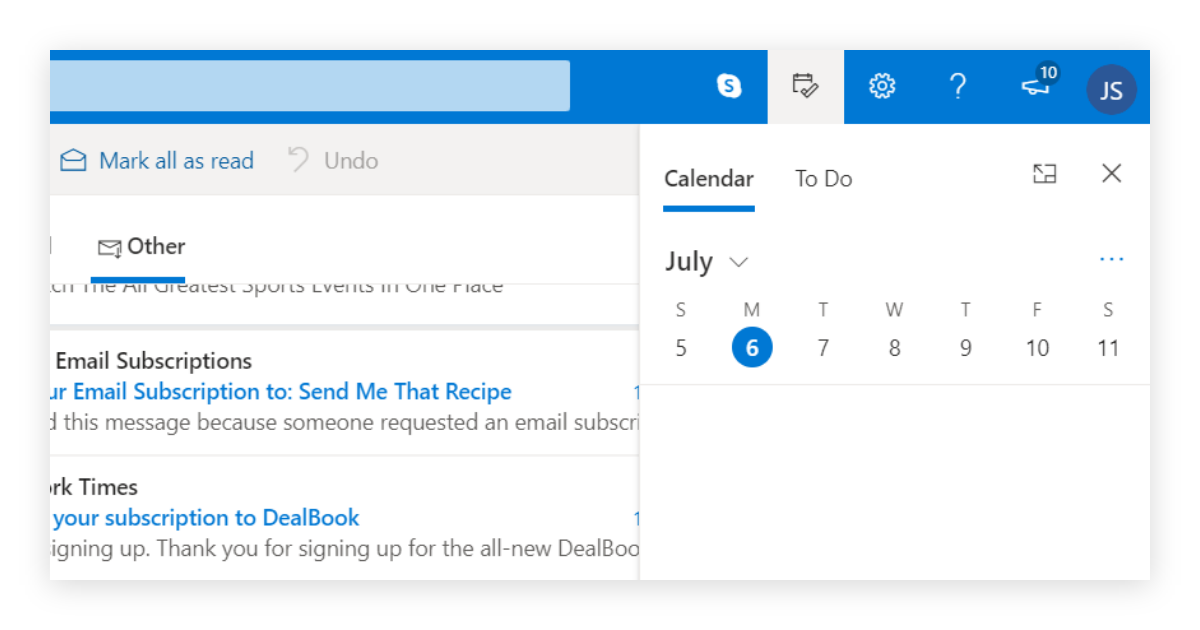
Last but not least, Outlook has a very robust rule management system. Rules can be added either from the rule management dialog or created when viewing an email. When a message is open, Outlook offers quick choices to set up a rule for specific attributes, like subject or sender email address.
最后但并非最不重要的一點是,Outlook具有非常強大的規則管理系統。 可以從規則管理對話框中添加規則,也可以在查看電子郵件時創建規則。 打開郵件時,Outlook提供快速選擇來設置特定屬性(例如主題或發件人電子郵件地址)的規則。
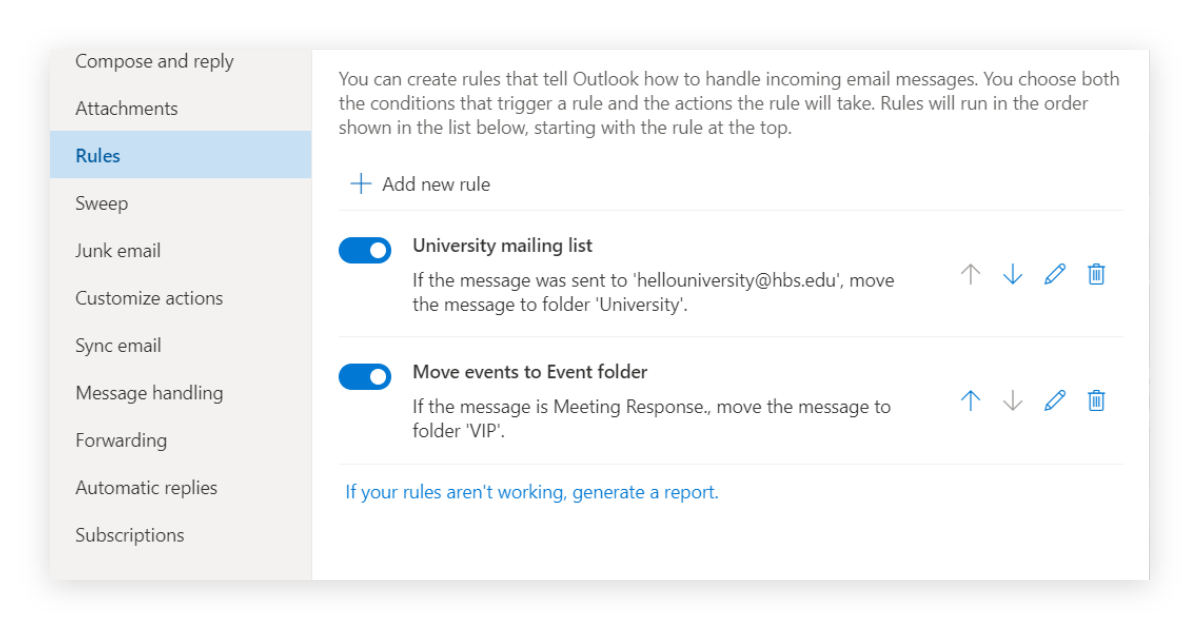
One limitation of the rule management system that some commands are only capable of running in the desktop application, therefore they cannot even be adjusted from the web interface. That also means if the desktop app is not open, those rules won’t be applied to incoming messages.
規則管理系統的限制之一是某些命令只能在桌面應用程序中運行,因此甚至無法從Web界面進行調整。 這也意味著,如果桌面應用未打開,則這些規則將不會應用于傳入消息。
嘿 (Hey)
Similar to others, Hey also uses labels to mark specific threads with a topic. However, these labels are not adequate for building various levels of hierarchy out of them. They’re merely just helping to filter through.
與其他人類似,Hey也使用標簽來標記帶有主題的特定主題。 但是,這些標簽不足以在其中構建各種層次的層次結構。 他們只是在幫助過濾。
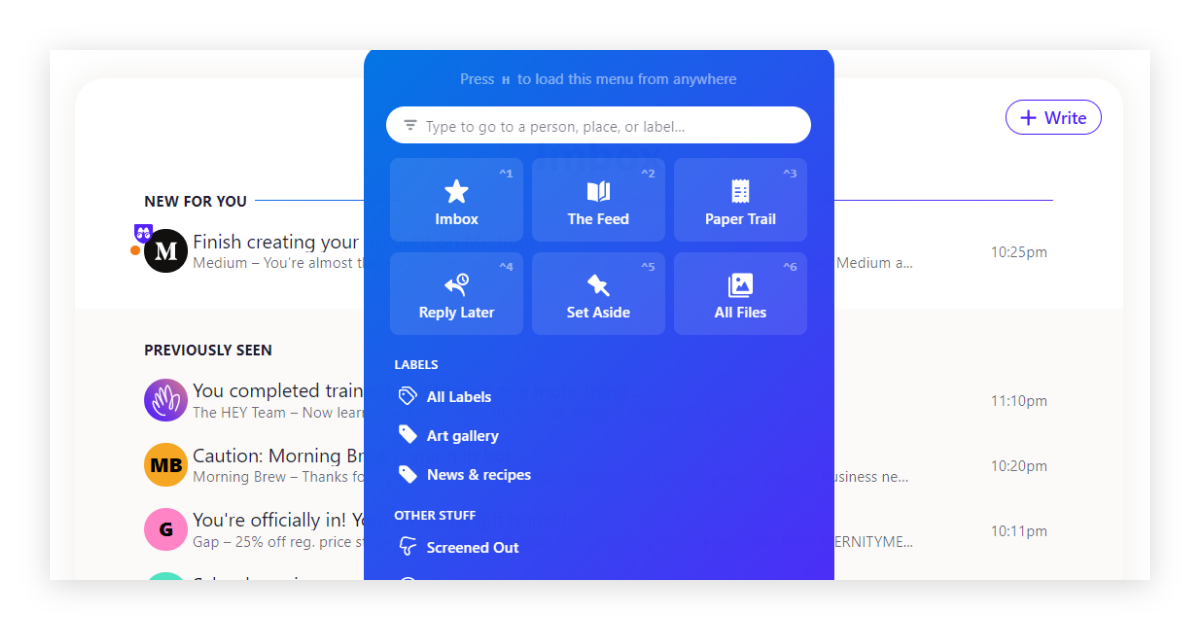
Beyond that, Hey offers the option to merge email threads, instead of managing them in folders. This behavior means if you have several different conversations in your inbox discussing the same topic, you can quickly bring them together, as if they were sent as a response to just one thread.
除此之外,Hey還提供了合并電子郵件線程的選項,而不是在文件夾中進行管理。 此行為意味著,如果收件箱中有多個討論同一主題的不同對話,則可以將它們Swift組合在一起,就像它們是作為對一個線程的響應而發送的一樣。
While the idea looks good on paper, there are two side-effects users need to get used to.
盡管這個想法在紙面上看起來不錯,但用戶需要習慣于兩個副作用。
First, thread merging is permanent, so if you accidentally select the wrong email chain to merge with, you’re stuck with your mistake. Second, as emails from many people come into the same thread, at times, it can be confusing to figure out who has received a response and who still needs an answer.
首先,線程合并是永久性的,因此,如果您不小心選擇了要合并的錯誤電子郵件鏈,您將陷入錯誤。 其次,隨著來自許多人的電子郵件有時進入同一線程,弄清楚誰收到了答復以及誰仍然需要答復可能會造成混淆。
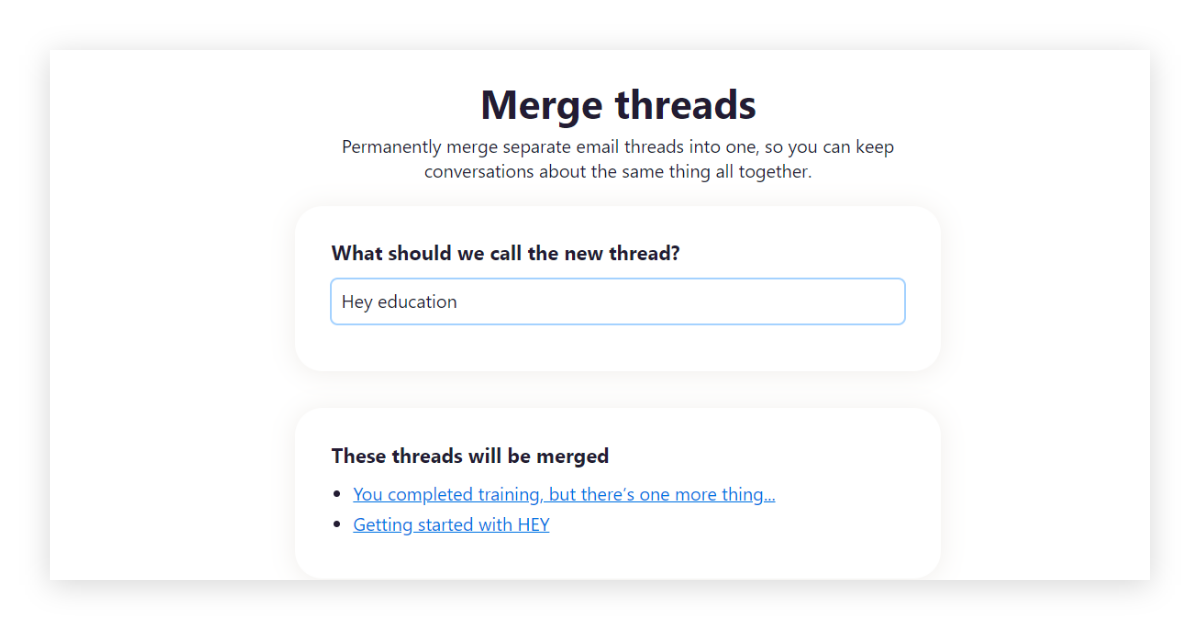
Another convenient feature that helps email organization is subject renaming.
可以幫助電子郵件組織的另一個方便功能是主題重命名。
You’re able to change the subject of existing emails that is only visible to you. Responses to these threads will still go out with their original subject line but on your side, you’ll see the custom phrase. Renaming is useful when the original subject doesn’t tell much about the email and you would get a better understanding next time with a new name.
您可以更改僅對您可見的現有電子郵件的主題。 對這些線程的響應仍將保留其原始主題行,但在您這一邊,您會看到自定義短語。 當原始主題對電子郵件的了解不多,并且下次使用新名稱可以使您更好地理解時,重命名很有用。
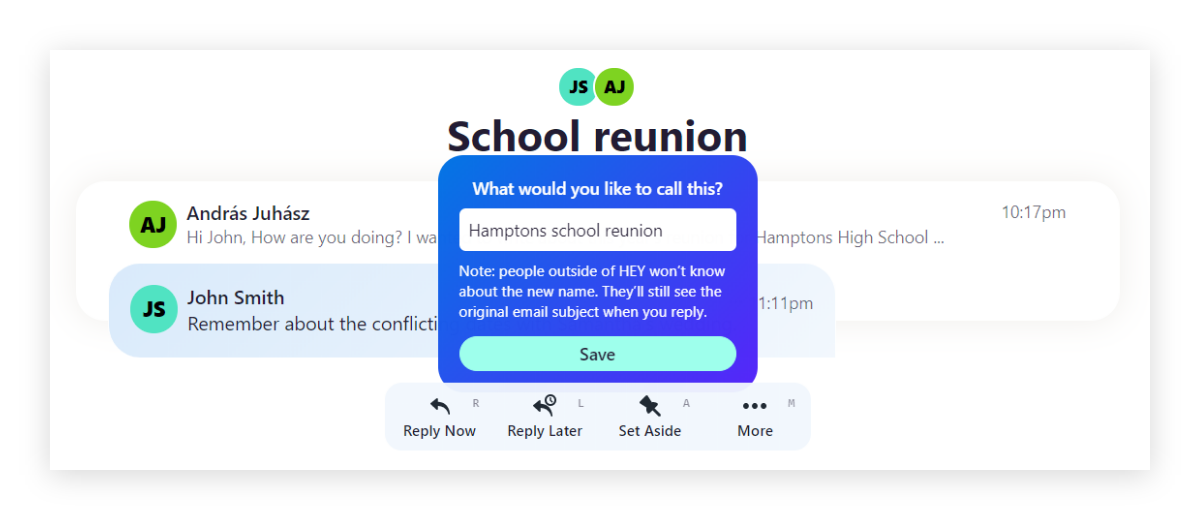
project項目管理的最佳方法:Outlook。 (🎉 The best approach for project management: Outlook.)
Outlook was born out of workplace needs and it’s still the best option to manage highly utilized inboxes. The combination of labelling, foldering, tasks, and the robust rule management capabilities give it an edge over the other two products.
Outlook是出于工作場所需求而誕生的,它仍然是管理高利用率收件箱的最佳選擇。 標簽,文件夾,任務和強大的規則管理功能的結合使它在其他兩種產品上具有優勢。
🔸附件 (🔸 Attachments)
Even though file-sharing services exist for a while, we still find it comfortable just to send documents over email. No surprise, all email providers offer file attachments in one way or another.
即使文件共享服務存在了一段時間,我們仍然發現僅通過電子郵件發送文檔仍然很舒適。 毫不奇怪,所有電子郵件提供商都以一種或另一種方式提供文件附件。
郵箱 (Gmail)
In Gmail, adding files to a message is an easy feat.
在Gmail中,將文件添加到郵件是一件容易的事。
On a computer, you can just drag and drop an attachment or press the attach button to browse for a file. The same behavior is present in the mobile app, you can add a document after pressing the attachment icon.
在計算機上,您可以拖放附件或按附件按鈕瀏覽文件。 移動應用程序中存在相同的行為,您可以在按附件圖標后添加文檔。
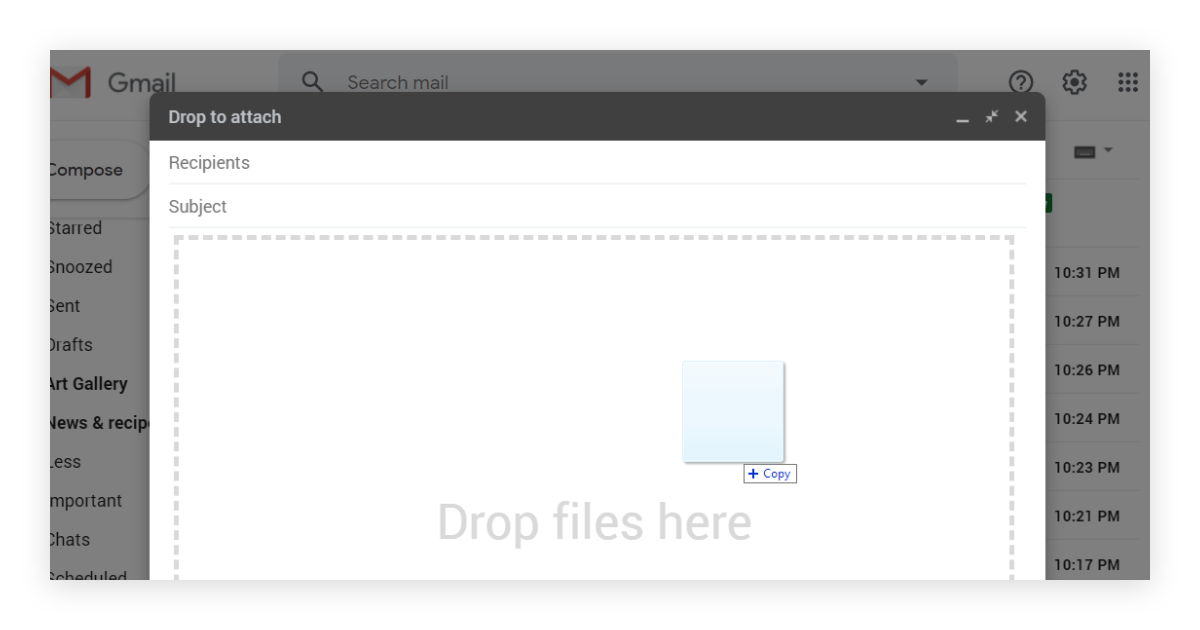
While adding files is easy, searching back for those becomes a bit more challenging. In Gmail, there are two ways to find attachments from past conversations.
雖然添加文件很容易,但是搜索這些文件變得更具挑戰性。 在Gmail中,有兩種方法可以從過去的對話中查找附件。
First, you can use the search to define that you’re looking for a message with an attachment, then you can further filter to the file type. Second, you can use a specific query from Google’s help portal for a closer match.
首先,您可以使用搜索來定義您正在尋找帶有附件的郵件,然后可以進一步過濾到文件類型。 其次,您可以使用Google 幫助門戶中的特定查詢來進行更緊密的匹配。
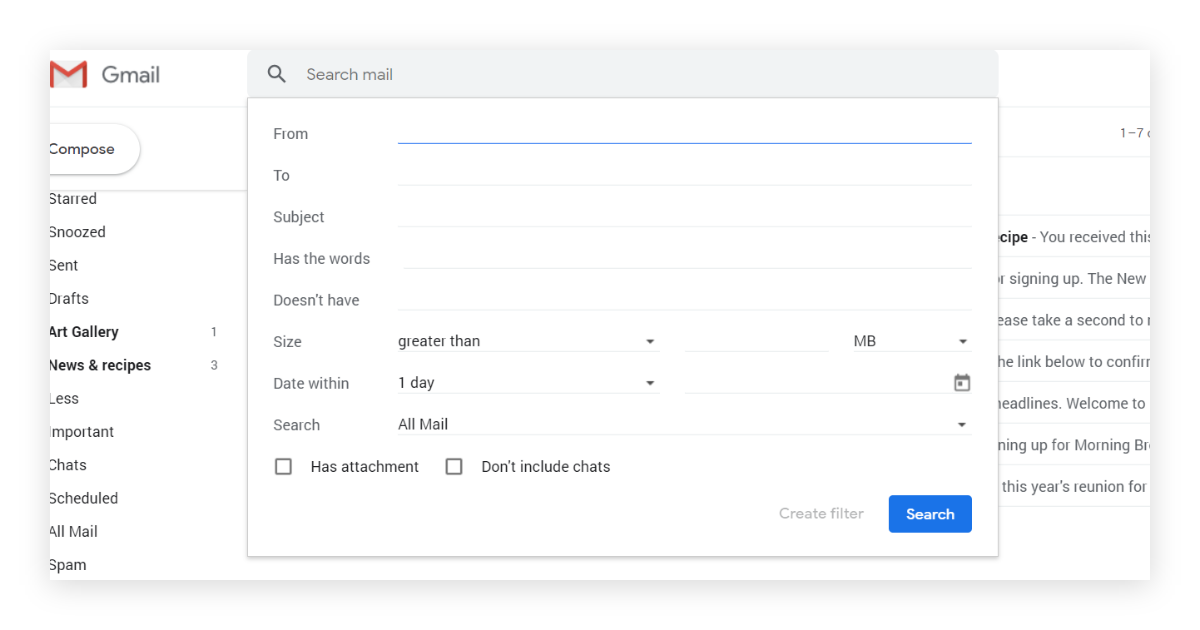
外表 (Outlook)
Outlook offers similar options for attaching files.
Outlook提供了類似的附加文件選項。
You can drag and drop items on the go, or you can press the attach button and browse for documents on the device. As an extra, Outlook’s web client tries to recommend relevant documents as a one-click option from OneDrive.
您可以隨時隨地拖放項目,也可以按附加按鈕瀏覽設備上的文檔。 另外,Outlook的Web客戶端嘗試從OneDrive中一鍵選擇推薦相關文檔。
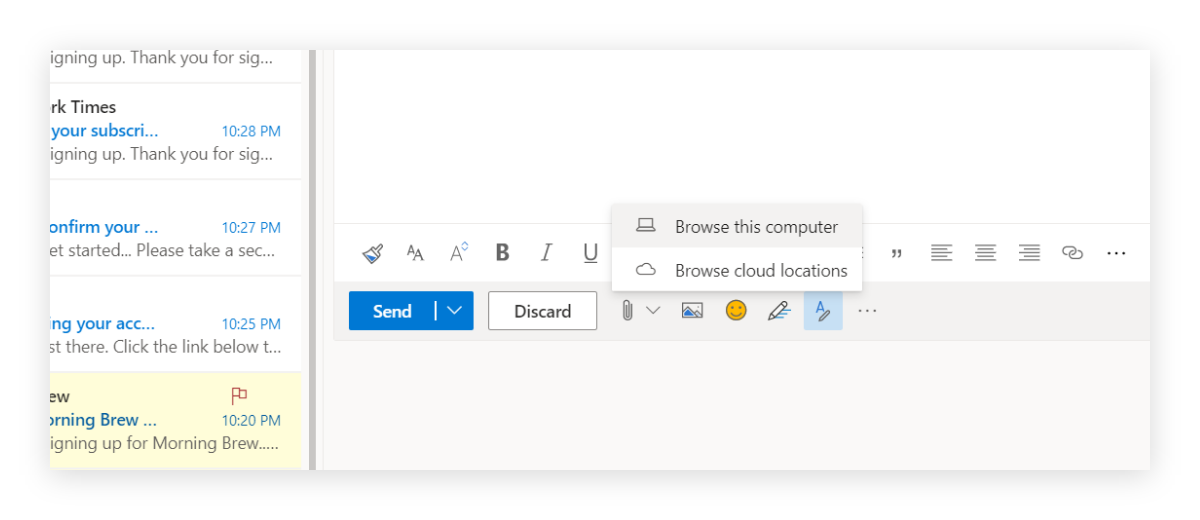
The search dialog in the web client has a stunning resemblance to Gmail’s approach. You’re able to search to sender email, subject, and date range, including other options.
Web客戶端中的搜索對話框與Gmail的方法極為相似。 您可以搜索發件人的電子郵件,主題和日期范圍,包括其他選項。
You’re also offered two choices to search for files. One way is to fill out the search fields with the relevant attributes and the other is to use Microsoft’s specific search expressions.
您還提供了兩種選擇來搜索文件。 一種方法是使用相關屬性填寫搜索字段,另一種方法是使用Microsoft的特定搜索表達式 。
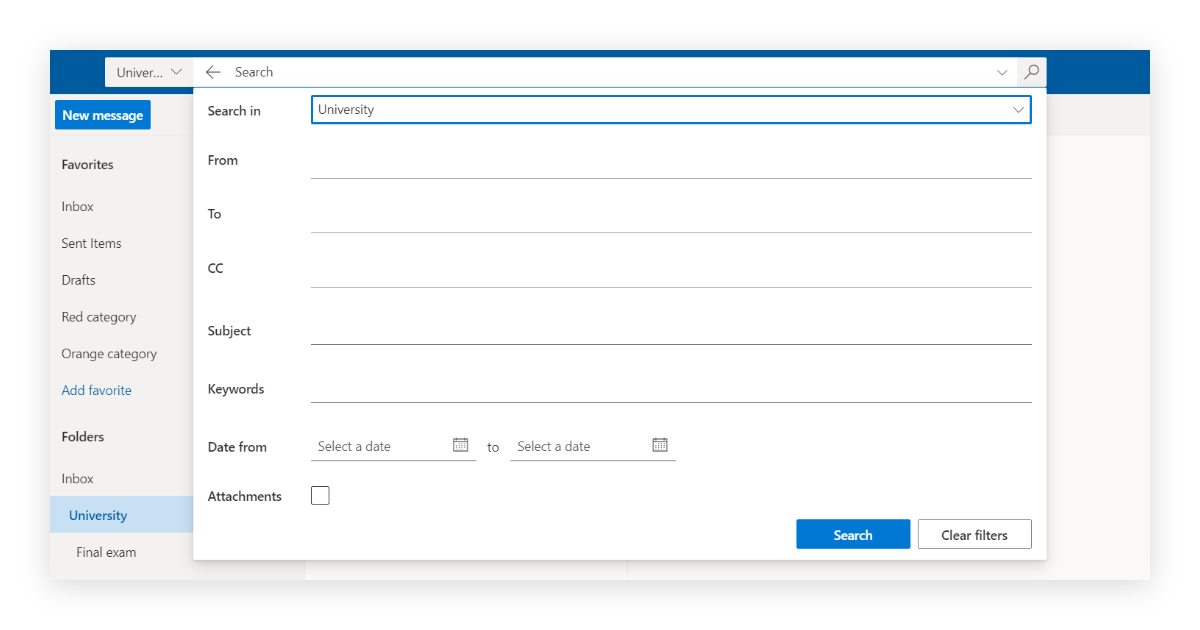
嘿 (Hey)
Adding files in Hey works mostly the same as in the other two services.
在Hey中添加文件的工作原理與在其他兩個服務中相同。
You can press the clips icon and browse, or you can drag and drop files to the email editor. The latter is not self-explanatory, as there are no changes on the user interface when you drag a document over.
您可以按剪輯圖標并瀏覽,也可以將文件拖放到電子郵件編輯器。 后者不是不言自明的,因為將文檔拖到用戶界面上時,不會進行任何更改。
What’s an extra here, that big file attachments are automatically converted into hyperlinks. Hey is hosting those files without an expiration date, as long they don’t exceed your overall inbox quota, which is 100 gigabytes.
這里還有一個額外的功能,即大文件附件會自動轉換為超鏈接。 嘿,這些文件的托管沒有到期日期,只要它們不超過您的總收件箱配額(100 GB)即可。

Searching for attachments is a different experience in Hey.
在Hey中,搜索附件是另一種體驗。
First, you can use the standard search to find attachments by their name. Based on my experience, it’s not always working. Sometimes the search box just forgets there is a file with a given name sitting in your mailbox.
首先,您可以使用標準搜索按附件的名稱查找附件。 根據我的經驗,它并不總是有效。 有時,搜索框只是忘記了郵箱中有一個具有給定名稱的文件。
Second, there is a dedicated All files page. The unique take on this section is the focus on attachments. Conversations are not listed here, but all the files from different threads, including file previews. Also, for every attachment, you can see the sender, the subject line, and the file size.
其次,有一個專用的“ 所有文件”頁面。 本節的獨特之處在于附件。 對話未在此處列出,而是所有來自不同線程的文件,包括文件預覽。 另外,對于每個附件,您都可以看到發件人,主題行和文件大小。

for附件的最佳方法:嘿。 (🎉 The best approach for attachments: Hey.)
All three email services offer similar experience for attaching and finding files. Where Hey wins is their dedicated files section, from where users can quickly filter to senders and file types. Albeit they should fix their main search to work consistently with filenames.
所有這三種電子郵件服務在附加和查找文件方面都提供類似的體驗。 Hey wins的地方是其專用文件部分,用戶可以從中快速過濾出發件人和文件類型。 盡管他們應該修復其主要搜索以與文件名保持一致。
🔸不需要的電子郵件和垃圾郵件過濾 (🔸 Unwanted emails and spam filtering)
Every provider’s best interest is to get spam filtered out from your inbox. But beyond that, what other tools are available to get rid of unwanted emails?
每個提供商的最大利益是從您的收件箱中過濾掉垃圾郵件。 但是除此之外,還有哪些其他工具可以用來清除不需要的電子郵件?
郵箱 (Gmail)
Google has one of the best, if not the best, spam filtering available. With close to 1.5 billion active Gmail users, the company is likely to have enough data to build up a robust algorithm to block unwanted senders.
Google擁有最好的(甚至不是最好的)垃圾郵件過濾工具之一。 擁有將近15億活躍Gmail用戶,該公司很可能擁有足夠的數據來構建強大的算法來阻止有害的發件人。
Gmail filters out spam messages in two steps.
Gmail分兩步過濾掉垃圾郵件。
In the first step, those messages are dropped that were reliably predicted as spam before. These emails are not even delivered to the spam folder, Gmail just rejects them. In the second step, if a message is likely to be spam, Google’s service lands it in the spam folder, from where it’s purged after 30 days. Users can also mark messages as spam manually (or even as phishing), if something was able to go through the cracks.
第一步,丟棄那些以前被可靠地預測為垃圾郵件的郵件。 這些電子郵件甚至沒有發送到垃圾郵件文件夾,Gmail只是拒絕了。 在第二步中,如果一條郵件很可能是垃圾郵件,則Google的服務會將其放置在30天后從其中清除的垃圾郵件文件夾中。 如果某些東西能夠通過裂縫,用戶還可以手動將郵件標記為垃圾郵件(甚至標記為網絡釣魚)。
The other option Gmail offers to filter out unwanted emails is to block specific senders. With blocking on, all messages from a sender will automatically go to the spam folder, no matter the content.
Gmail提供的另一種過濾掉不需要的電子郵件的選項是阻止特定的發件人。 啟用阻止后,無論內容如何,??來自發件人的所有郵件都將自動轉到垃圾郵件文件夾。
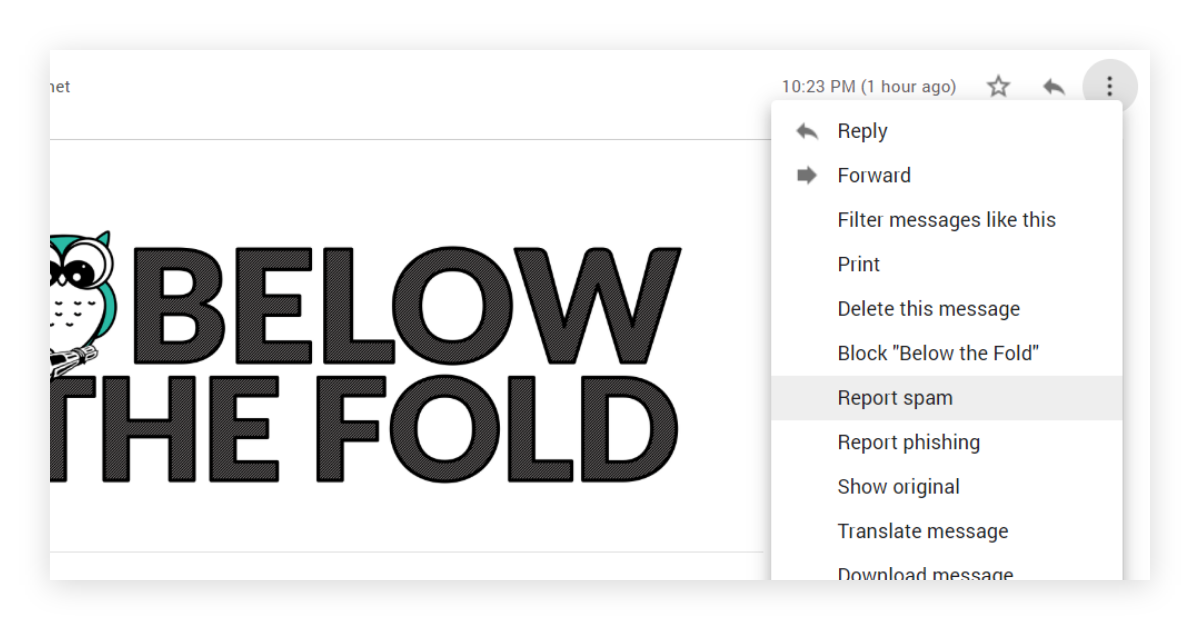
外表 (Outlook)
Outlook is also taking the classic approach when it comes to managing spam.
在管理垃圾郵件方面,Outlook也采用經典方法。
Similar to other providers, Microsoft’s service tries to filter out unwanted messages to a separate junk folder. Based on personal experience, it can be a hit and miss, with account activation messages landing in the wrong place at times.
與其他提供程序類似,Microsoft的服務嘗試將不需要的郵件過濾到單獨的垃圾文件夾。 根據個人經驗,帳戶激活消息有時會落在錯誤的位置,因此一擊即失。
As Outlook is often used in the corporate environment, it provides several options to fine-tune how spam moderation works. For whitelisting, users can define safe sender and safe recipient lists. For blacklisting, they can specify blocked senders, blocked top-level domains, and even blocked character encoding lists.
由于Outlook通常用于公司環境中,因此它提供了多種選項來微調垃圾郵件審核的工作方式。 對于白名單,用戶可以定義安全發件人列表和安全收件人列表。 對于黑名單,他們可以指定阻止的發件人,阻止的頂級域,甚至阻止的字符編碼列表。
For each incoming message, Outlook offers two security options: to block a sender or mark the email as junk. Blocking senders in Outlook will result in the same punishment as in Gmail; all their emails will end up in the junk folder automatically.
對于每個傳入的郵件,Outlook提供了兩個安全選項:阻止發件人或將電子郵件標記為垃圾郵件。 在Outlook中阻止發件人將導致與Gmail相同的處罰; 他們所有的電子郵件都將自動保存在垃圾文件夾中。

嘿 (Hey)
Hey also has built-in spam filtering. All recognized spam is going to a dedicated spam folder, though you can also mark emails as spammy by clicking in the three-dot menu.
嘿還具有內置的垃圾郵件過濾功能。 盡管您還可以通過單擊三點菜單將電子郵件標記為垃圾郵件,所有公認的垃圾郵件都將轉到專用的垃圾郵件文件夾。
What is not clear at this point is just how good Hey’s spam filter is, and how many Nigerian princes are getting through.
目前尚不清楚Hey的垃圾郵件過濾器的性能如何,以及有多少尼日利亞王子正在通過。
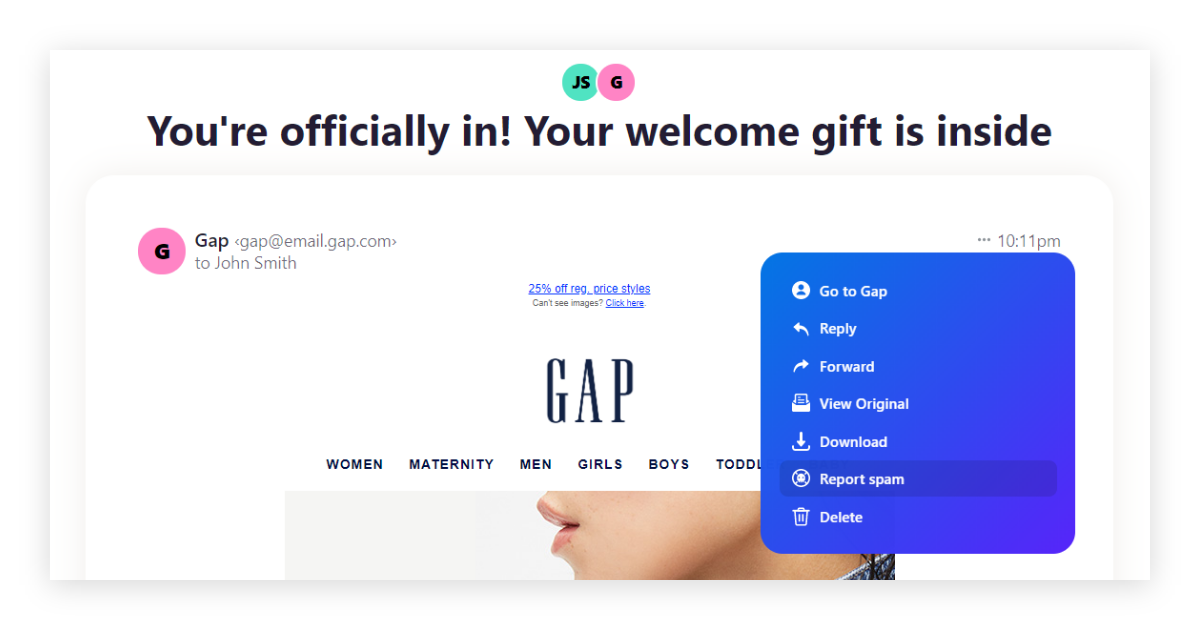
Hey’s primary approach for filtering first-time senders, The screener, was already discussed above. This feature acts as a gatekeeper, only letting through emails from approved contacts.
上面已經討論了 Hey篩選首次發件人的主要方法Screener 。 此功能充當網守,僅允許通過已批準聯系人的電子郵件。
A badge on the main screen denotes how many senders are waiting for a thumbs up or down. The primary benefit here is definitely less emails in your inbox. The disadvantage that some critical emails might be not coming through automatically.
主屏幕上的標志表示有多少發件人正在等待大拇指向上或向下。 這里的主要好處是收件箱中的電子郵件肯定更少。 某些關鍵電子郵件可能不會自動通過的缺點。
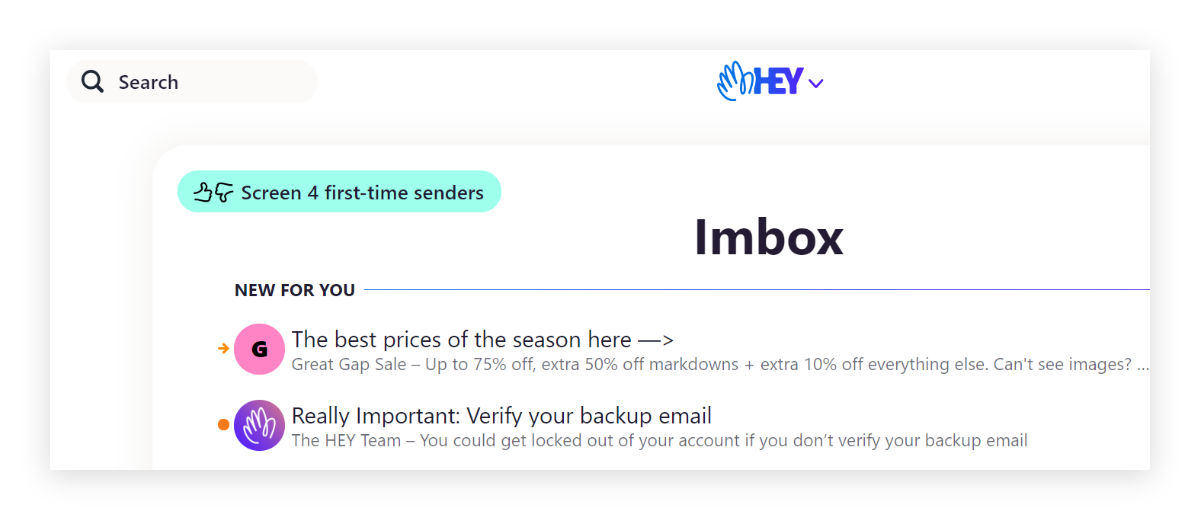
for不需要的電子郵件和垃圾郵件過濾的最佳方法:Gmail和Hey。 (🎉 The best approach for unwanted emails and spam filtering: Gmail and Hey.)
The best solution will depend on how you use your mailbox. If you need automatic sorting, a strong spam filter and you’re usually not surprised who is emailing you, then Gmail is better. But if you receive a high number of emails with some surprise senders, and you want to treat your mailbox as a walled garden, then Hey wins.
最佳解決方案將取決于您如何使用郵箱。 如果您需要自動排序,強大的垃圾郵件過濾器,并且通常不奇怪是誰向您發送電子郵件,那么Gmail會更好。 但是,如果您收到大量帶有一些令人驚訝的發件人的電子郵件,并且希望將您的郵箱視為有圍墻的花園,那么嘿贏了。
🔸通知和隱私 (🔸 Notifications and privacy)
One of the main ways to get informed about a new email is through notifications. So how often do these services buzz your phone?
通知是獲取新電子郵件的主要方法之一。 那么,這些服務多久會向您的手機發送一次嗡嗡聲?
郵箱 (Gmail)
Gmail has customizable notification options that lets you tune the push messages in three different ways.
Gmail具有可自定義的通知選項,可讓您以三種不同方式調整推送消息。
First, you can decide if you want to get a notification for:
首先,您可以決定是否要收到以下通知:
- all emails, 所有電子郵件,
- only for high priority ones (that Gmail considers as “high priority”), 僅適用于高優先級的郵件(Gmail認為是“高優先級”),
- or you don’t want to receive any notification at all. 或者您根本不想收到任何通知。
Second, you can select the option to notify for every message. If this is checked, Gmail will send a notification after every new message and response. If unchecked, then only new emails will be buzzing your phone, and responses to previous threads would arrive as a silent notification.
其次,您可以選擇針對每條消息進行通知的選項。 如果選中此選項,則Gmail將在每封新郵件和新回復后發送一條通知。 如果未選中,則只有新的電子郵件會在您的手機上發出嗡嗡聲,并且對先前線程的響應將作為靜默通知到達。
Third, you can set up notification for individual labels. This setting can be a powerful utility if you’re managing your tags strictly and having certain categories that are more important than others.
第三,您可以為各個標簽設置通知。 如果您要嚴格管理標簽并擁有比其他類別更重要的某些類別,則此設置可能是功能強大的實用程序。
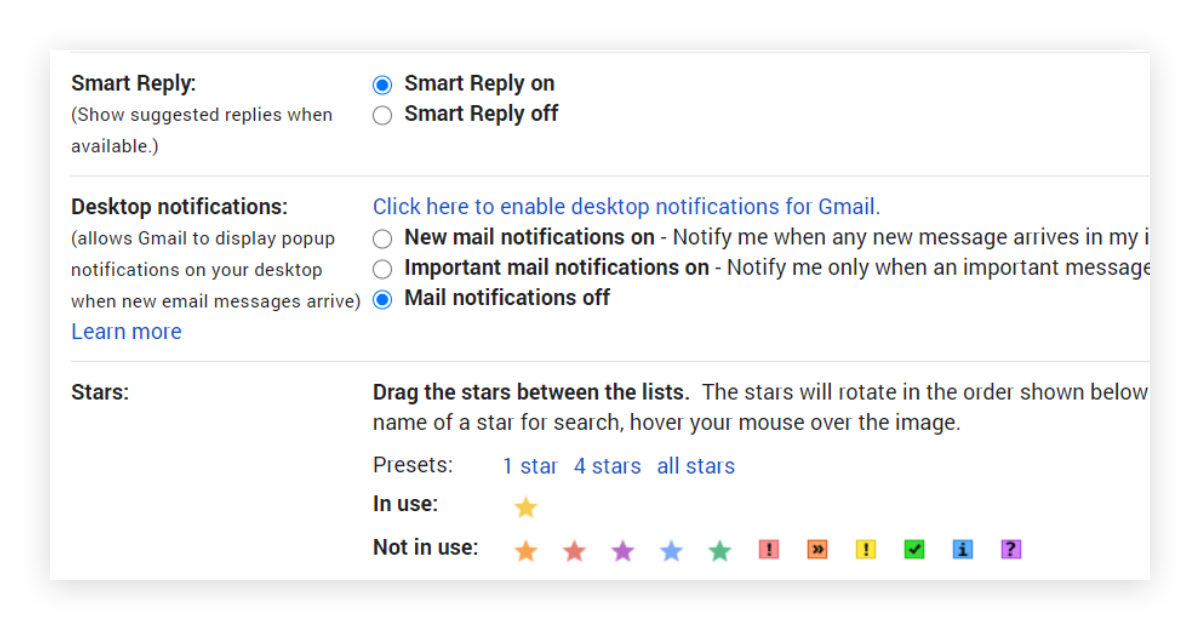
Regarding security and privacy, Gmail shows image files from emails automatically, even if those might potentially include some tracking pixels.
關于安全性和隱私性,Gmail會自動顯示電子郵件中的圖像文件,即使這些文件可能包含一些跟蹤像素 。
The good thing, that all images are routed through Google’s own servers, so any company trying to know your IP address or exact location will probably fail to get that. The bad thing that the fact if you opened a specific email and when you did that is still routed through the tracking pixel.
好消息是,所有圖像都通過Google自己的服務器路由,因此任何試圖知道您的IP地址或確切位置的公司都可能無法獲取該圖像。 不好的事實是,即使您打開了特定的電子郵件并在打開時也仍然會通過跟蹤像素進行路由。
Another essential security question that was raised in the past years if Google is reading your messages or not.
過去幾年中,無論Google是否閱讀您的郵件,都提出了另一個重要的安全性問題。
Before 2017, Google was admittedly using the text of emails to personalize the ads shown to you. That doesn’t mean that actual humans were reading personal emails; they were just consumed by machine learning algorithms. They stopped this practice after a negative exposure in the press.
在2017年之前,Google無疑使用電子郵件的文字來個性化顯示給您的廣告。 這并不意味著實際的人正在閱讀個人電子郵件。 它們只是被機器學習算法所消耗。 在新聞界受到負面曝光后,他們停止了這種做法。
One way Google is actually helping privacy-conscious users is to make unsubscribe links more visible. Usually, those links are hidden at the bottom of the emails, with a light gray font to make it harder to find. In most cases, Gmail is displaying the unsubscribe link next to the sender’s name, so it becomes easier to get rid of unwanted mailing lists.
Google實際上幫助關注隱私的用戶的一種方法是使退訂鏈接更加可見。 通常,這些鏈接被隱藏在電子郵件的底部,并使用淺灰色字體使其更難找到。 在大多數情況下,Gmail會在發件人姓名旁邊顯示退訂鏈接,因此可以輕松擺脫不需要的郵件列表。

外表 (Outlook)
Compared to Gmail, Outlook has straightforward and simple rules in terms of email notifications. You can either get notifications for every email (including the ones outside of the focused inbox) or none.
與Gmail相比,Outlook在電子郵件通知方面具有簡單明了的規則。 您可以獲取每封電子郵件的通知(包括重點收件箱之外的電子郵件),也可以不接收任何通知。
There is only one way to fine-tune this behavior. By creating a rule to move messages to another folder (outside of the primary inbox), emails won’t trigger a notification, even if all the notification settings are turned on.
只有一種方法可以微調此行為。 通過創建將郵件移動到另一個文件夾(在主收件箱之外)的規則,即使打開了所有通知設置,電子郵件也不會觸發通知。
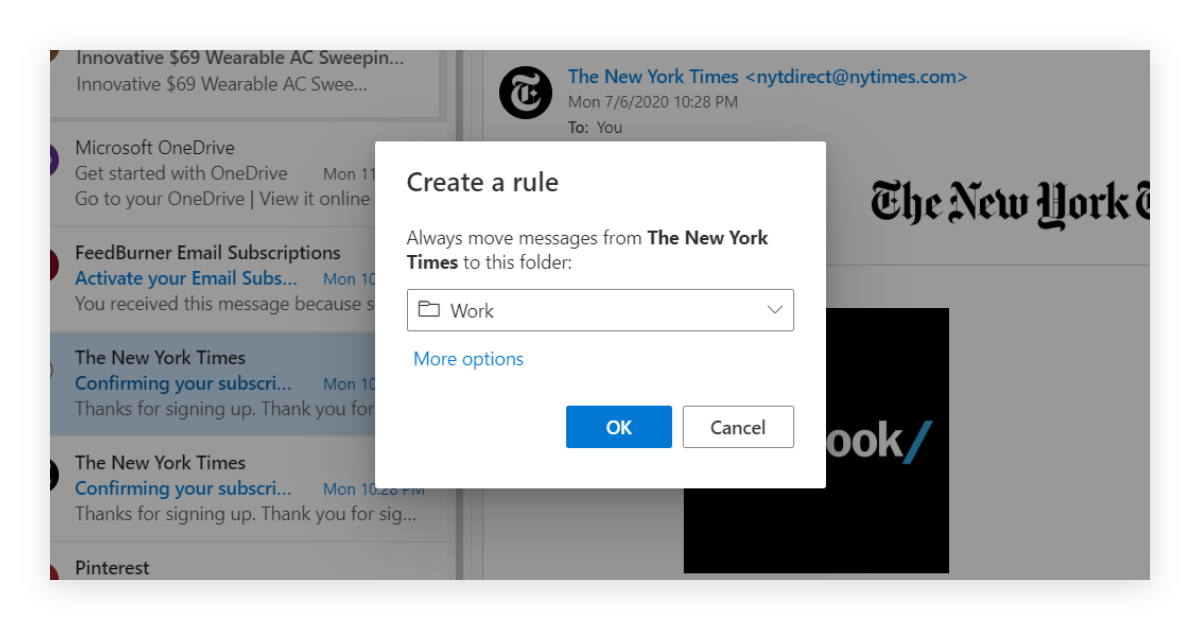
For images, Outlook is taking an opposite stance.
對于圖像,Outlook采取相反的立場。
In Outlook, all images are blocked by default, no matter which folder they arrive to. That means if you don’t enable pictures for a specific email manually, then it won’t trigger any tracking pixels.
在Outlook中,默認情況下,所有圖像均被阻止,無論它們到達哪個文件夾。 這意味著,如果您沒有手動為特定的電子郵件啟用圖片,那么它將不會觸發任何跟蹤像素。
Microsoft’s email solution offers granular choices to allow images. You can enable pictures for an individual message, a particular sender or domain, or for all messages by default.
微軟的電子郵件解決方案提供了允許圖像的細粒度選擇。 默認情況下,您可以為單個郵件,特定發件人或域或所有郵件啟用圖片。
Similar to Gmail, Outlook is also placing recognized unsubscribe links to the top of the message, so it’s easier to get out of any marketing communication you haven’t really subscribed to — so long they respect your goodbye choice.
與Gmail相似,Outlook還在郵件頂部放置了公認的退訂鏈接,因此,更容易擺脫您尚未真正訂閱的任何營銷交流-只要他們尊重您的再見選擇即可。

嘿 (Hey)
Hey is proudly communicating their notification management practices as one of the standout features. They’re not proactively asking for notification permissions in their app, which is an interesting take compared to all other mobile apps today.
嘿,我們很自豪地將其通知管理實踐作為出色的功能之一進行交流。 他們并沒有主動在其應用程序中請求通知權限,這與當今所有其他移動應用程序相比是一個有趣的舉動。
Instead, users can enable notifications for two different things.
而是,用戶可以為兩種不同的事物啟用通知。
First, users can set notifications for specific senders. That way, they would receive a notification each time when an individual sends a message.
首先,用戶可以設置特定發件人的通知。 這樣,每次有人發送消息時,他們都會收到通知。
Second, users are able to enable notifications for specific threads. Imagine that you would get different emails from your boss, but only one is time-critical. So instead of getting a notification for every message, your phone would only buzz once you receive a response to a specific thread.
其次,用戶能夠啟用特定線程的通知。 想象一下,您會從老板那里收到不同的電子郵件,但是只有一封是時間緊迫的。 因此,手機不會收到每條消息的通知,只會在您收到對特定主題的回復后才會發出嗡嗡聲。
While gradually enabling notifications is a good approach, users need time to set those up manually. Beyond that, in the current version, sadly, there is not a place to disable notifications for particular threads or people centrally.
雖然逐漸啟用通知是一種不錯的方法,但用戶需要時間手動設置這些通知。 除此之外,令人遺憾的是,在當前版本中,沒有地方可以集中禁用特定線程或人員的通知。
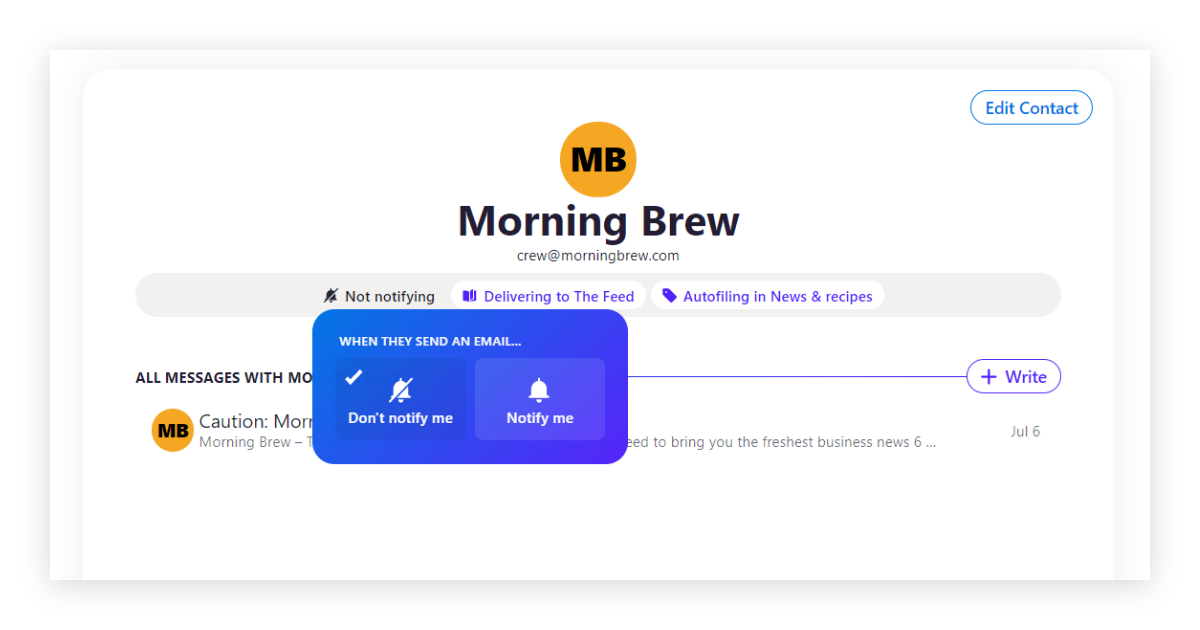
In terms of privacy, Hey highlights their “spy tracker” blocking capabilities. This behavior technically means that they have a pre-defined list of the biggest corporate messaging providers (like Mailchimp), and they proactively prevent their tracking pixels from loading.
在隱私方面,Hey強調了其“間諜跟蹤器”的阻止功能。 從技術上講,此行為意味著他們具有最大的公司消息傳遞提供者(如Mailchimp)的預定義列表,并且可以主動防止加載其跟蹤像素。
In theory, this prevents any information from being sent back to the companies when you open a message — such as location, device type, IP address, or the date and time you opened the email.
從理論上講,這可以防止您在打開消息時將任何信息發送回公司,例如位置,設備類型,IP地址或打開電子郵件的日期和時間。
In practice, it’s not stopping tracking links in email to function similarly. When you open a link from these emails, all the above information might still be recorded and sent to a company.
實際上,它不會停止跟蹤電子郵件中的鏈接以發揮類似的作用。 當您打開這些電子郵件中的鏈接時,以上所有信息可能仍會被記錄并發送給公司。
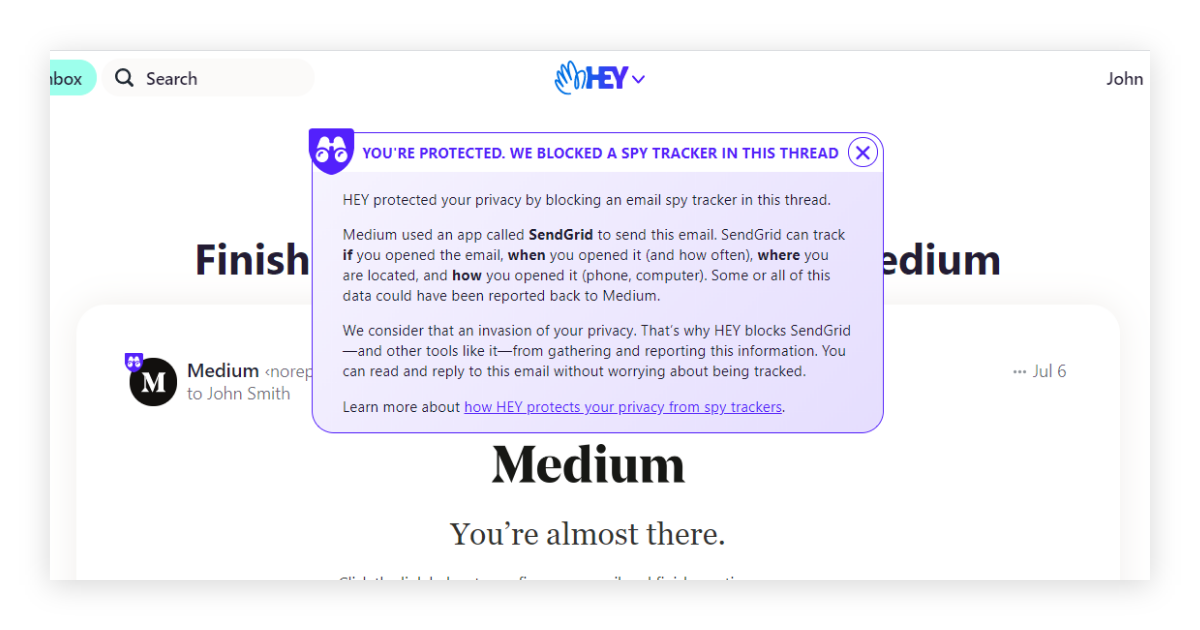
for通知和隱私的最佳方法:嘿。 (🎉 The best approach for notifications and privacy: Hey.)
Hey is having an advantage in reducing the number of email notifications. They’re not only making you to turn on notifications proactively for senders and threads, but they also filter out non-verified first time senders from buzzing your phone.
嘿在減少電子郵件通知數量方面具有優勢。 它們不僅使您主動為發件人和線程打開通知,而且還過濾掉未經驗證的初次發件人,避免他們嗡嗡電話。
🔸額外功能 (🔸 Extra features)
Beyond the standard email features, each provider is adding something extra to the core experience.
除了標準的電子郵件功能,每個提供商都在核心體驗中添加了一些額外的東西。
郵箱 (Gmail)
Gmail was known about experimenting with new features. In the past, there was a dedicated section called Gmail Labs to test out various experiments. While the option is not there anymore, some functionalities graduated to the final product from this initiative.
Gmail因嘗試新功能而聞名。 過去,有專門的部分稱為Gmail實驗室,以測試各種實驗。 盡管選項不再存在,但某些功能已從該計劃逐步升級為最終產品。
One of the features Gmail recently introduced is a confidential mode. This setting lets you set an expiry date for messages and encrypts both the message itself and any attachments up to 5 years. If you want to revoke the message earlier after the email is already sent, you can do that anytime.
Gmail最近推出的功能之一是機密模式。 通過此設置,您可以設置郵件的有效期,并加密郵件本身和最長5年的附件。 如果您想在發送電子郵件后更早撤消該消息,則可以隨時執行此操作。
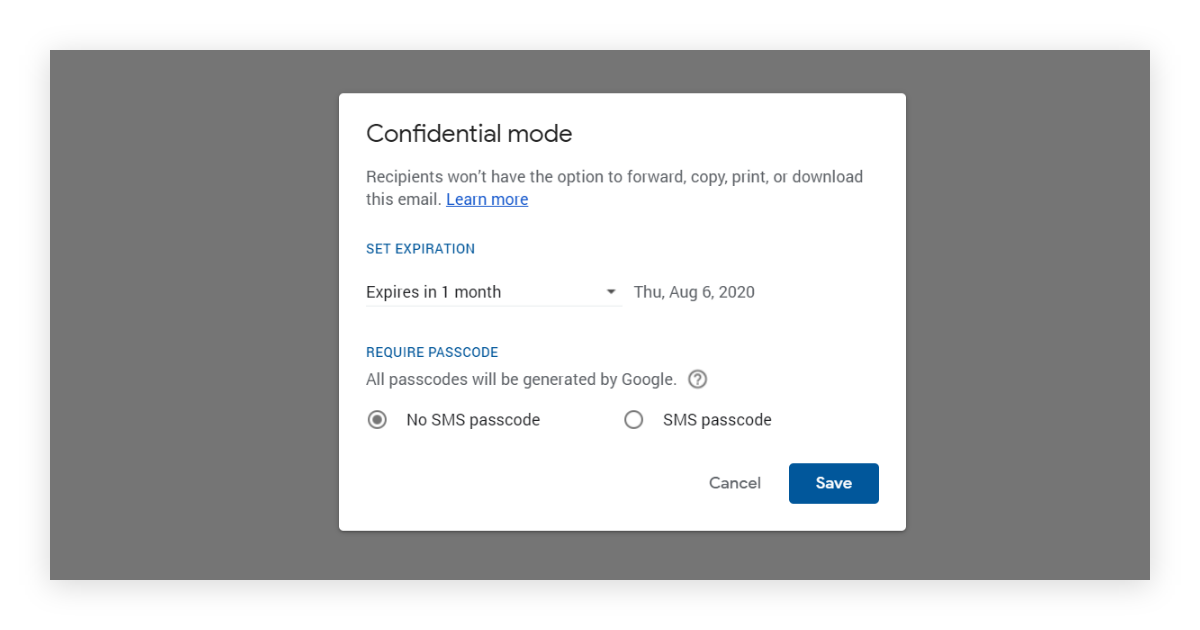
Another feature that is unique to Gmail is response suggestions. Google offers both smart reply and smart compose functionalities. While smart reply automatically generates quick responses based on the email content like “You’re welcome!”, smart compose is trying to predict the next words you would write in an email response.
Gmail獨有的另一個功能是響應建議。 Google提供智能回復和智能撰寫功能。 雖然智能回復會根據電子郵件內容(例如“不客氣!”)自動生成快速響應,但智能撰寫正在嘗試預測您將在電子郵件響應中寫的下一個單詞。
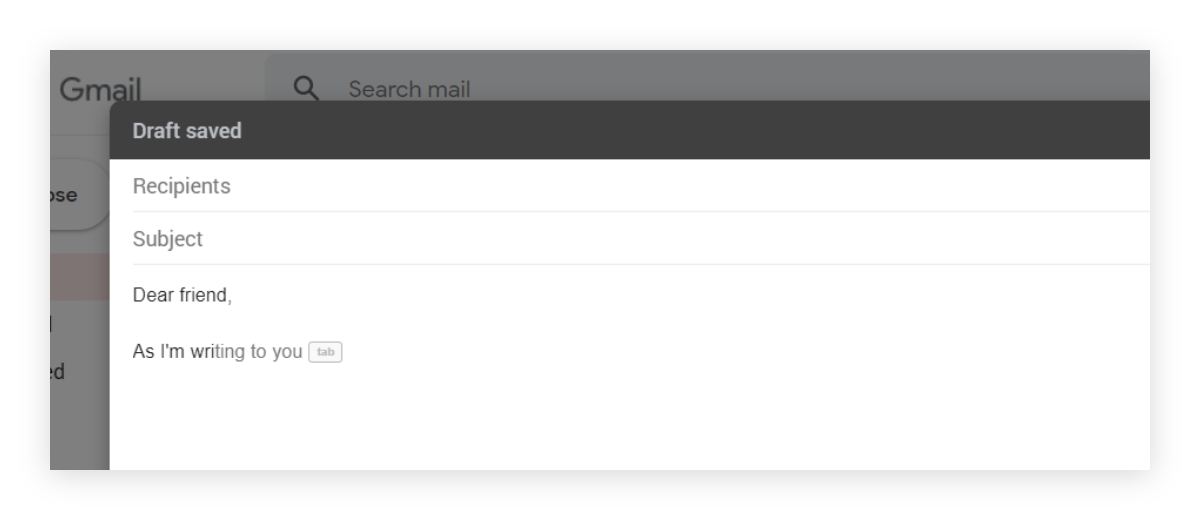
The last extra feature Gmail has is scheduled send. With this, Google provides the ability to set a time when a specific message should leave your email outbox and delivered to the addressee. While other email startups popularized the idea, it’s slowly becoming a core functionality.
Gmail的最后一項附加功能是預定發送。 借助此功能,Google可以設置特定郵件應何時離開您的電子郵件發件箱并傳遞給收件人的時間。 當其他電子郵件初創公司普及該想法時,它正逐漸成為一項核心功能。
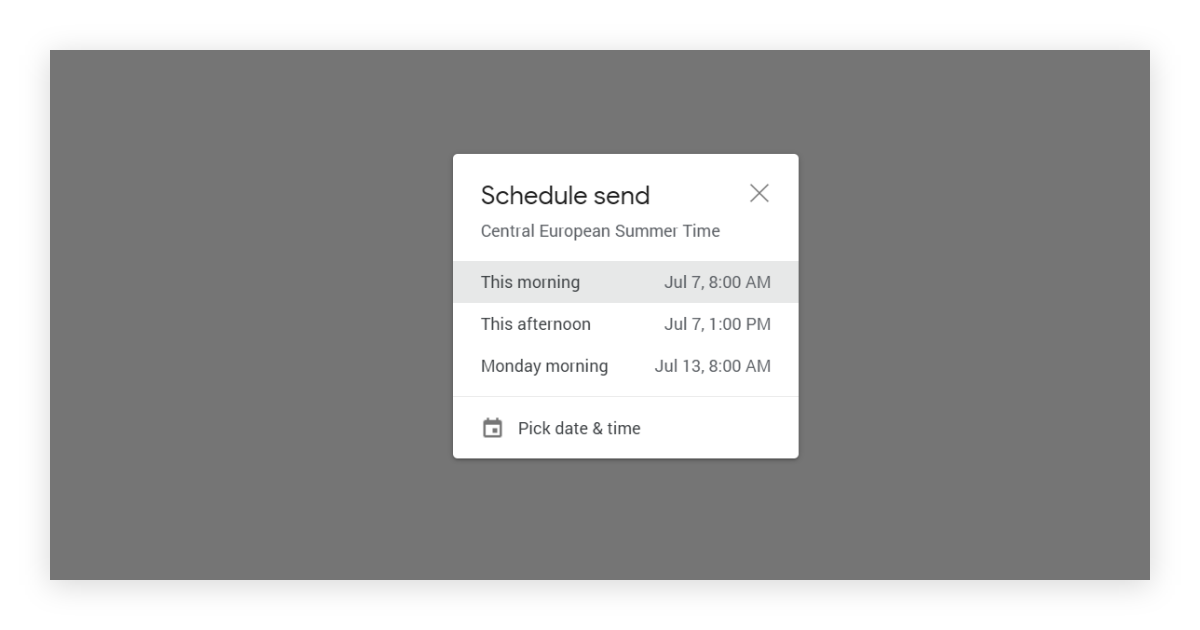
外表 (Outlook)
Outlook is closer to regular email clients in terms of features, that doesn’t stop Microsoft from bringing a few extra capabilities to their users.
在功能方面,Outlook更接近常規電子郵件客戶端,這并不妨礙Microsoft向其用戶提供一些額外功能。
One of Outlook’s specialties are called search folders. With this functionality, users can create a folder out of their search queries, so they appear one click away in the main menu. This feature is similar to saving queries or filters in other project management tools.
Outlook的特色之一是搜索文件夾 。 使用此功能,用戶可以從搜索查詢中創建一個文件夾,因此一鍵式出現在主菜單中。 此功能類似于將查詢或過濾器保存在其他項目管理工具中。
The other extra feature Outlook offers is scheduled send, comparable to Gmail’s approach. The functionality appears as “Send later” when drafting an email, available next to the send button. From there, users can pick the date and time when the message should be sent out.
Outlook提供的其他額外功能是預定發送功能,與Gmail的方法相當。 草擬電子郵件時,該功能顯示為“稍后發送”,位于發送按鈕旁邊。 從那里,用戶可以選擇發送消息的日期和時間。
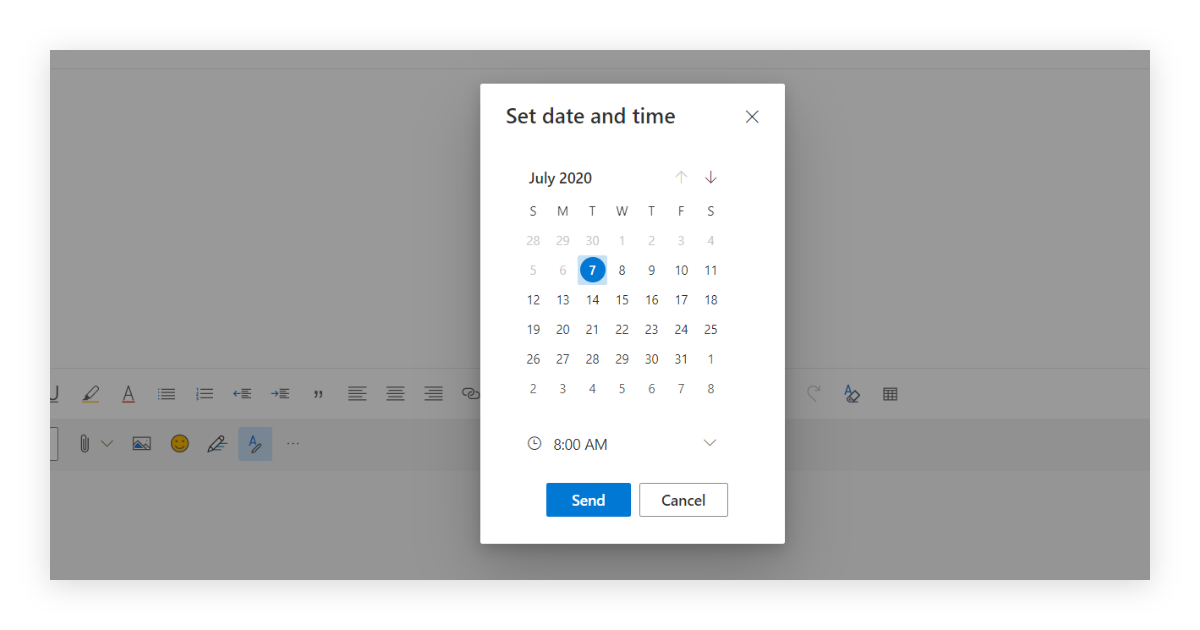
嘿 (Hey)
Hey, being a newcomer in the inbox management field, is already starting with a few unique takes.
嗨,作為收件箱管理領域的新手,已經開始嘗試一些獨特的方法。
The first thing people can notice on the default screen is something called Read together. It appears next to the unread emails and does nothing else than to display all the unopened emails below each other. From this view, it’s not possible to respond to emails directly, but there is a button on the bottom of the page to “Mark all as seen”.
人們在默認屏幕上注意到的第一件事是稱為“ 一起閱讀” 。 它顯示在未讀電子郵件的旁邊,除了將所有未打開的電子郵件顯示在彼此下方之外,沒有任何其他作用。 從這種觀點來看,不可能直接回復電子郵件,但是頁面底部有一個按鈕“將所有內容標記為可見”。
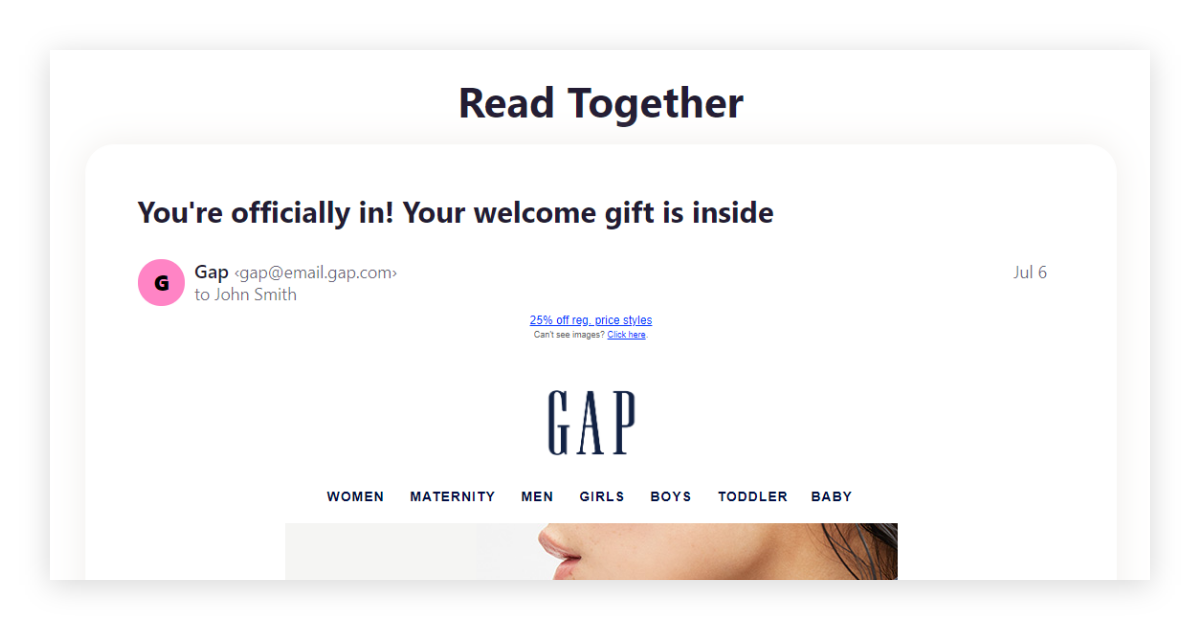
Hey also tries to bring a solution for the scenario when email threads are getting out of hand, but there is no option to unsubscribe from messages.
Hey also tries to bring a solution for the scenario when email threads are getting out of hand, but there is no option to unsubscribe from messages.
They introduce an Ignore this thread button, which stops future responses from appearing in the inbox. If this is active, replies will still be available, but you won’t see them unless you go to the specific thread.
They introduce an Ignore this thread button, which stops future responses from appearing in the inbox. If this is active, replies will still be available, but you won't see them unless you go to the specific thread.
You can turn “ignoring thread” off anytime, if you would choose to receive new messages from the thread.
You can turn “ignoring thread” off anytime, if you would choose to receive new messages from the thread.
On one hand, it’s a handy feature for irrelevant exchanges. On the other hand, it can get you into trouble if you’re not responding to an email, even if you’re called by name there.
On one hand, it's a handy feature for irrelevant exchanges. On the other hand, it can get you into trouble if you're not responding to an email, even if you're called by name there.
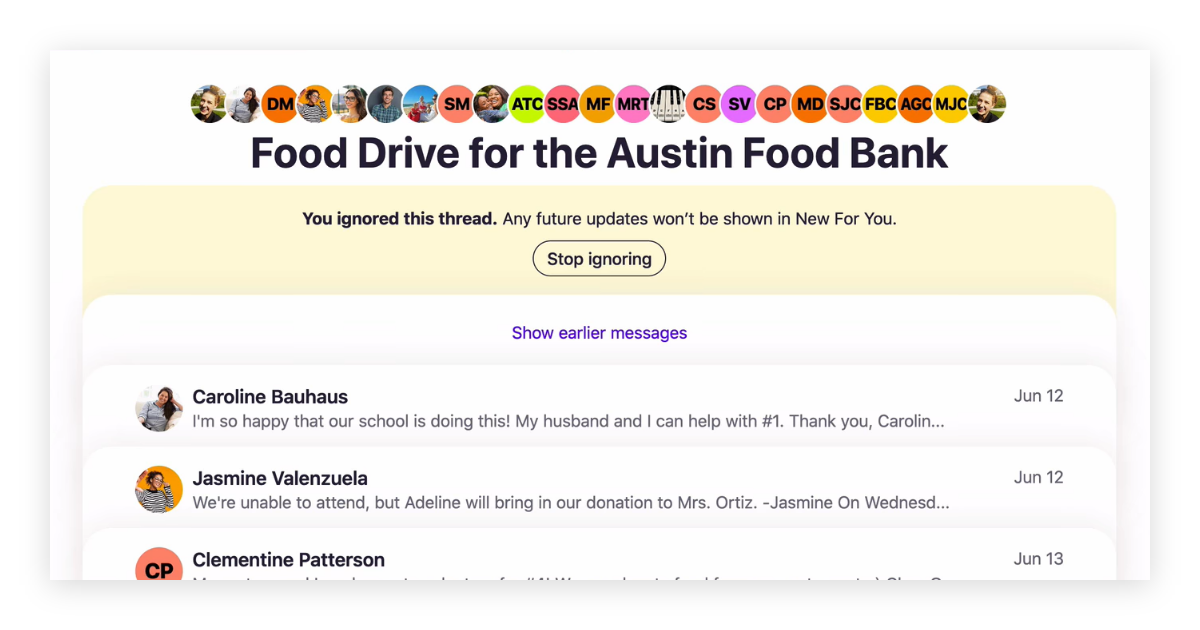
🎉 The best collection of extra features: Gmail. (🎉 The best collection of extra features: Gmail.)
With the scheduled sending, smart response suggestions, and the confidential messages, Gmail offers the most distinctive and unique features out of the three providers. These extras are not just making it easier to draft emails but they do add further functionalities on top of the core experience.
With the scheduled sending, smart response suggestions, and the confidential messages, Gmail offers the most distinctive and unique features out of the three providers. These extras are not just making it easier to draft emails but they do add further functionalities on top of the core experience.
🔸 Conclusion (🔸 Conclusion)
In this lengthy article, you got more information about how Gmail, Outlook, and Hey deal with multiple aspects of email management.
In this lengthy article, you got more information about how Gmail, Outlook, and Hey deal with multiple aspects of email management.
Gmail is good at automatically taking care of your emails based on an educated algorithmic guess. It can deal with email sorting, filtering out spam, or predicting your next words in a sentence. It works without a lot of manual setup. If you’re okay with that, that means that you don’t get to see what happens behind the hood, why individual emails are landing in Promotions or the Updates folder.
Gmail is good at automatically taking care of your emails based on an educated algorithmic guess. It can deal with email sorting, filtering out spam, or predicting your next words in a sentence. It works without a lot of manual setup. If you're okay with that, that means that you don't get to see what happens behind the hood, why individual emails are landing in Promotions or the Updates folder.
Outlook was clearly built for enterprise clients and still the best solution for heavy project management needs. It offers all the standard functionalities most email clients have and provides several extras on top of that — like focused inbox, or connecting emails to to-dos and calendar events. In contrast to Gmail, Outlook does not try to sort out everything itself, but instead, gives powerful tools to the hand of its users. Then, it will be their choice if they choose to use them.
Outlook was clearly built for enterprise clients and still the best solution for heavy project management needs. It offers all the standard functionalities most email clients have and provides several extras on top of that — like focused inbox, or connecting emails to to-dos and calendar events. In contrast to Gmail, Outlook does not try to sort out everything itself, but instead, gives powerful tools to the hand of its users. Then, it will be their choice if they choose to use them.
Hey is a fresh take on an email service with a lot of different approaches than standard providers. Their attitude on reviewing first-time senders, creating internal notes, and voluntarily enabling notifications feels new and unique. Beyond that, they deliver on most of the basic features as well. While they’re still around their first version, their service creates plenty of room for competitors to catch up.
Hey is a fresh take on an email service with a lot of different approaches than standard providers. Their attitude on reviewing first-time senders, creating internal notes, and voluntarily enabling notifications feels new and unique. Beyond that, they deliver on most of the basic features as well. While they're still around their first version, their service creates plenty of room for competitors to catch up.
Below, you can see which provider won in each category:
Below, you can see which provider won in each category:
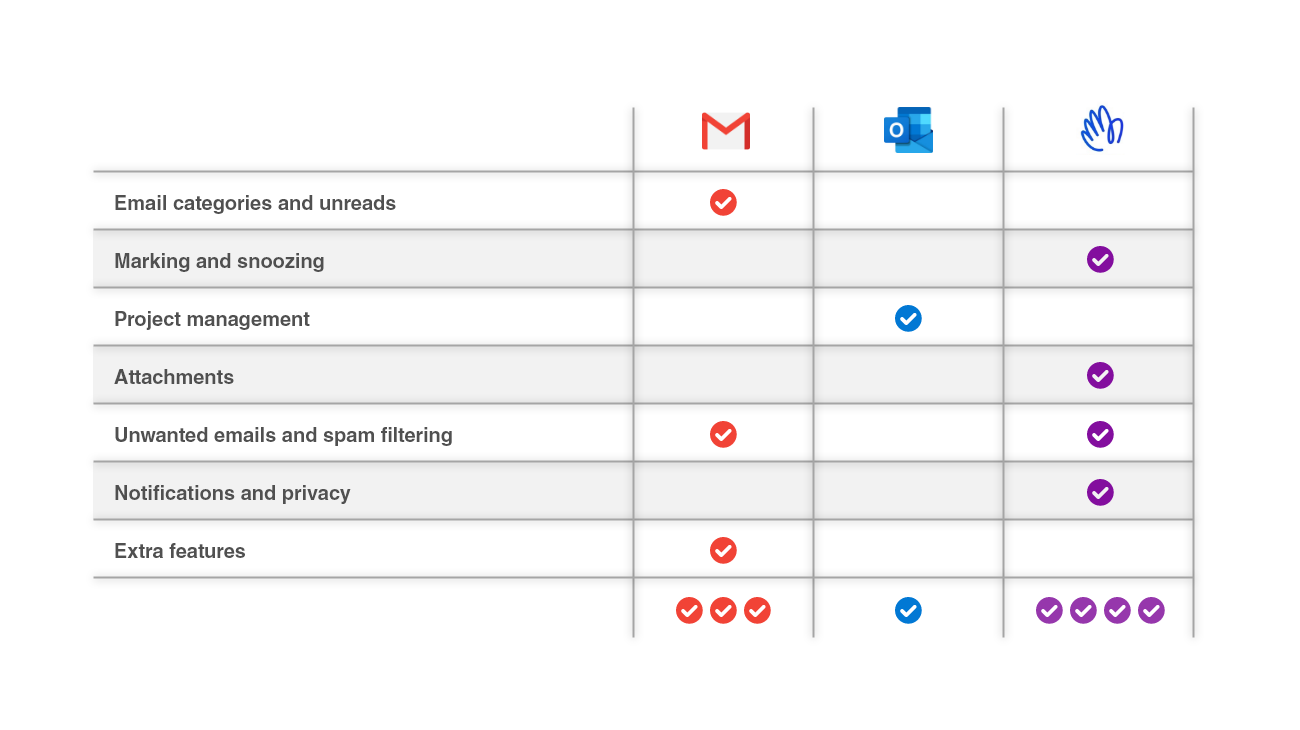
But to be honest, this is somewhat an unfair comparison. While you can start using Gmail and Outlook for free with their ad-supported tiers, Hey only offers paid services with a 14-day trial.
But to be honest, this is somewhat an unfair comparison. While you can start using Gmail and Outlook for free with their ad-supported tiers, Hey only offers paid services with a 14-day trial.
What's the best email service today? (What’s the best email service today?)
Quoting a familiar economist response: it depends.
Quoting a familiar economist response: it depends.
If you don’t look at the price tag of $99 per year, it’s Hey.
If you don't look at the price tag of $99 per year, it's Hey .
They provide the best overall email service today, and some refreshing takes to make email fun again (if it’s not an oxymoron). Hey admits that the product is still version one, thus lacking some more advanced features from other providers. Also, they still need to mature their own functionalities too.
They provide the best overall email service today, and some refreshing takes to make email fun again (if it's not an oxymoron). Hey admits that the product is still version one, thus lacking some more advanced features from other providers. Also, they still need to mature their own functionalities too.
If you look at the price tag, the winner is Gmail.
If you look at the price tag, the winner is Gmail .
Google offers its email service for free, a proven product used by 1.5 billion accounts. Gmail is flexible and supports different workflows with their inbox types. If you want to get rid of the ads and subscribe to G Suite (which offers more than just the business Gmail), that would cost $72 in a year, even with your custom domain configured.
Google offers its email service for free, a proven product used by 1.5 billion accounts. Gmail is flexible and supports different workflows with their inbox types. If you want to get rid of the ads and subscribe to G Suite (which offers more than just the business Gmail), that would cost $72 in a year, even with your custom domain configured.
If you’re already using Microsoft services, Outlook is your best option.
If you're already using Microsoft services, Outlook is your best option.
Microsoft also offers its email service for free, with a starting storage of 15 GB. A subscription to Microsoft 365 includes the professional version of Outlook (among other Office products) for $70 per year. If you already have Office at work, it’s tough to justify the cost for any additional email service, as Outlook still has a solid offering.
Microsoft also offers its email service for free, with a starting storage of 15 GB. A subscription to Microsoft 365 includes the professional version of Outlook (among other Office products) for $70 per year. If you already have Office at work, it's tough to justify the cost for any additional email service, as Outlook still has a solid offering.
Choosing the best solution (Choosing the best solution)
Should you stick with your current provider? Is it worth to pay the difference? It’s not an easy choice. If you’re thinking of changing your provider, it’s worth to consider the following:
Should you stick with your current provider? Is it worth to pay the difference? It's not an easy choice. If you're thinking of changing your provider, it's worth to consider the following:
- Are you part of an IT-managed organization with a single choice? Are you part of an IT-managed organization with a single choice?
- Are you using email for personal matters, for school, or work? Are you using email for personal matters, for school, or work?
- How much time do you spend a day managing your inbox? How much time do you spend a day managing your inbox?
- How many messages are you getting a week? How many messages are you getting a week?
- Are those emails from people you know or from mostly strangers? Are those emails from people you know or from mostly strangers?
- Are you using email as a project management tool? Are you using email as a project management tool?
- And last… are you dissatisfied with your current email choice? And last… are you dissatisfied with your current email choice?
Disclaimer: The author is not affiliated with any of the companies mentioned here. The article aimed to be a weighted comparison of three popular email providers, with the admission that the author is an “inbox zero” person.
Disclaimer: The author is not affiliated with any of the companies mentioned here. The article aimed to be a weighted comparison of three popular email providers, with the admission that the author is an “inbox zero” person.
翻譯自: https://blog.prototypr.io/who-is-providing-the-best-email-experience-today-5e3776c240e7
在當今移動互聯網時代
本文來自互聯網用戶投稿,該文觀點僅代表作者本人,不代表本站立場。本站僅提供信息存儲空間服務,不擁有所有權,不承擔相關法律責任。 如若轉載,請注明出處:http://www.pswp.cn/news/275309.shtml 繁體地址,請注明出處:http://hk.pswp.cn/news/275309.shtml 英文地址,請注明出處:http://en.pswp.cn/news/275309.shtml
如若內容造成侵權/違法違規/事實不符,請聯系多彩編程網進行投訴反饋email:809451989@qq.com,一經查實,立即刪除!













![[知乎回答] 前端是否要學習 Node.js?](http://pic.xiahunao.cn/[知乎回答] 前端是否要學習 Node.js?)




)